A Japanese living room offers a serene escape from the chaos of modern life, emphasizing harmony, balance, and a deep connection with nature. This design philosophy, often referred to as Zen, is not merely about aesthetics but about creating a space that promotes peace, mindfulness, and simplicity. It revolves around the principle of "Ma," the appreciation of empty space, which allows key elements to stand out and the room to breathe. By incorporating natural materials, minimalist furniture, and a neutral color palette, you can transform your living area into a tranquil sanctuary that soothes the mind and spirit.
1. Japanese Living Room with Shoji Screen Dividers
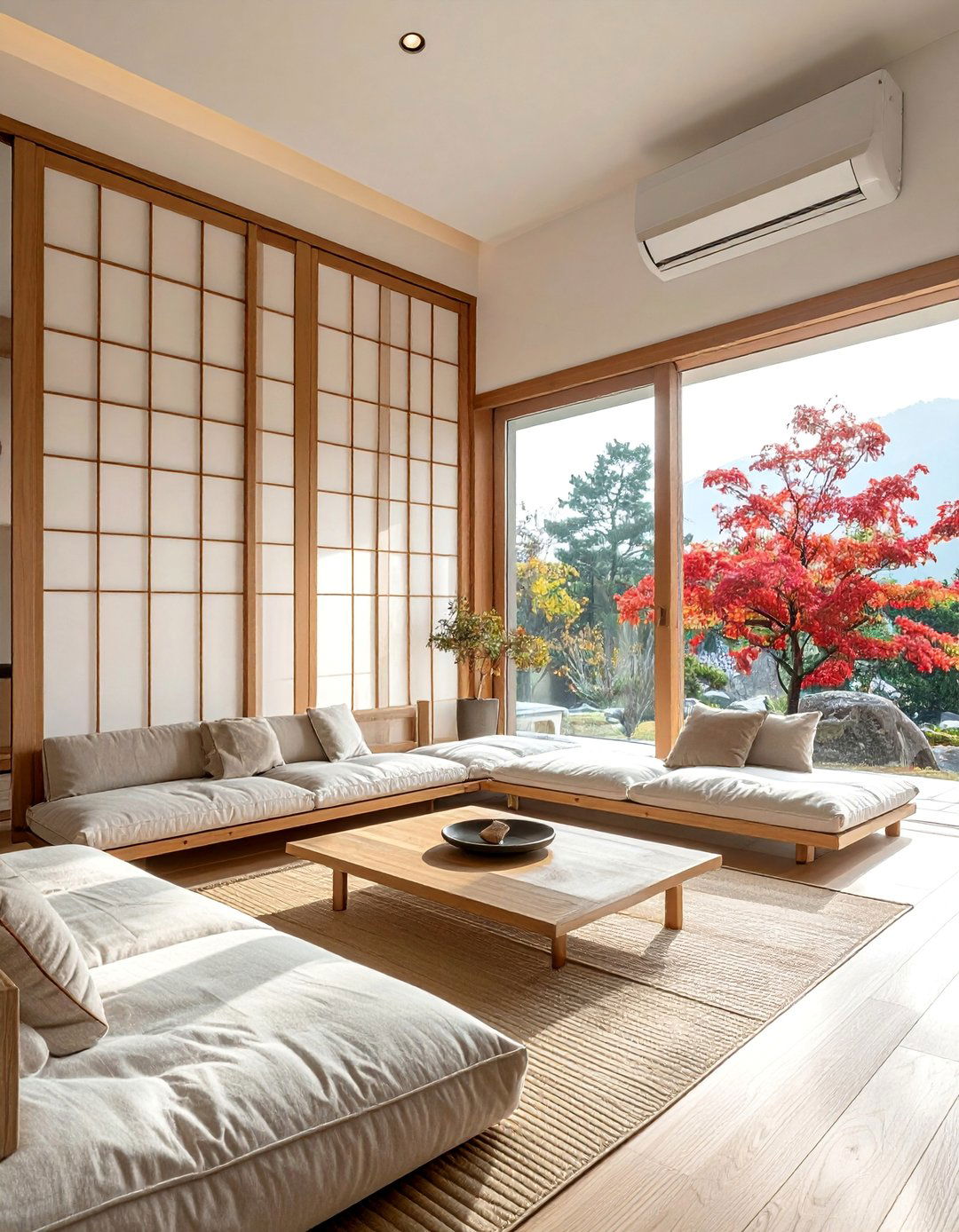
Shoji screens are a quintessential element in a Japanese living room, serving as elegant and functional room dividers or window coverings. These translucent paper screens, set in a wooden lattice frame, diffuse light beautifully, creating a soft, ambient glow that enhances the room's serene atmosphere. Using them allows for flexible space management; you can partition a larger area to create a more intimate zone or use them to conceal storage without disrupting the minimalist aesthetic. Their lightweight construction and simple lines contribute to the overall feeling of airiness and uncluttered openness, which is central to Japanese interior design principles.
2. A Japanese Living Room with Tatami Mat Flooring
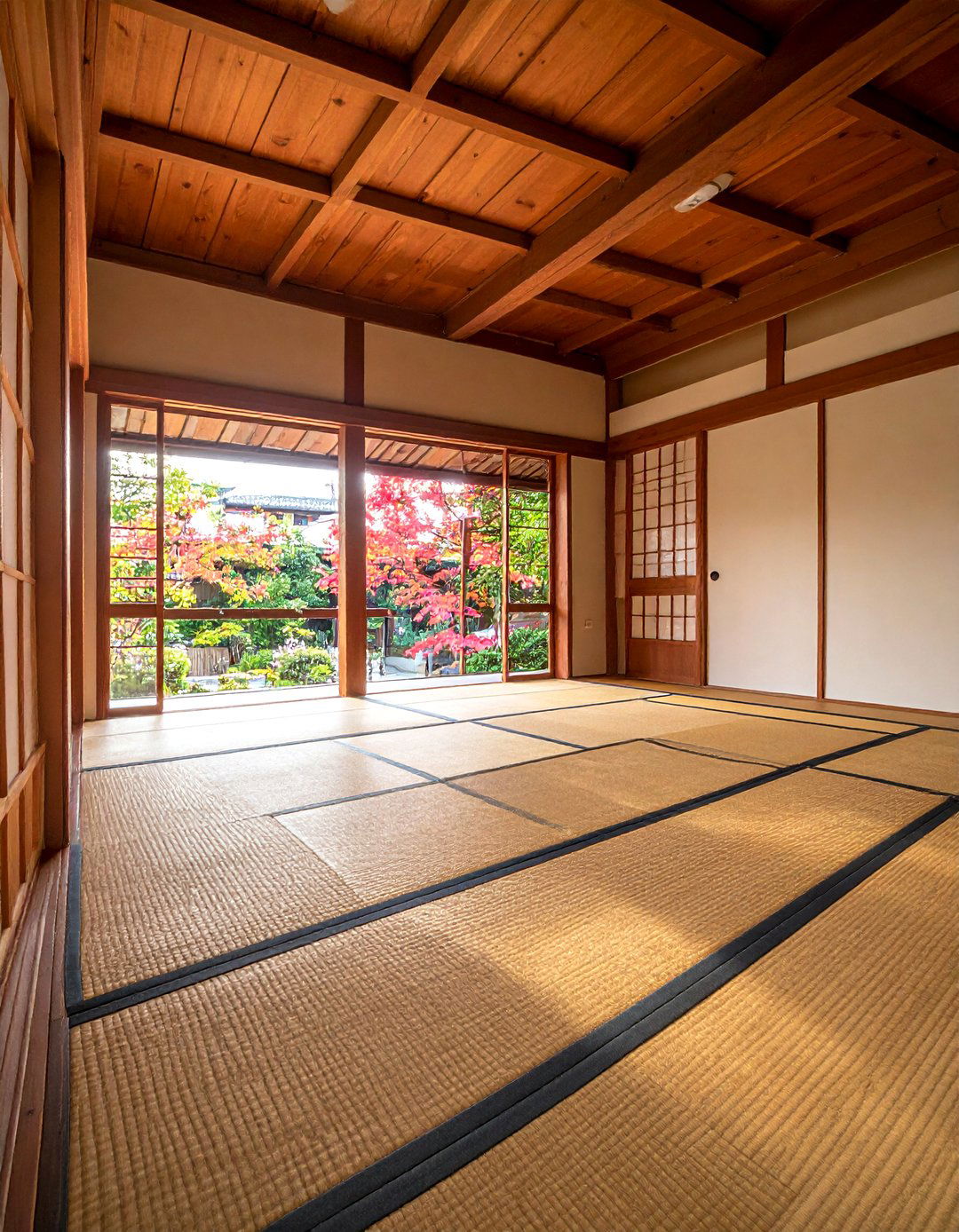
Incorporating tatami mats is a traditional and authentic way to establish a Japanese living room. These woven straw mats provide a firm yet comfortable surface for sitting and walking, instantly grounding the space with a natural texture and a subtle, fresh scent. Traditionally, the layout of tatami mats follows specific rules to bring good fortune. In a modern context, you can use them to define a specific area, such as a seating or tea ceremony zone. Their simple, geometric forms add a layer of understated elegance and encourage a floor-level lifestyle, fostering a closer connection to the home and a more mindful way of living.
3. Low-Profile Furniture in a Japanese Living Room
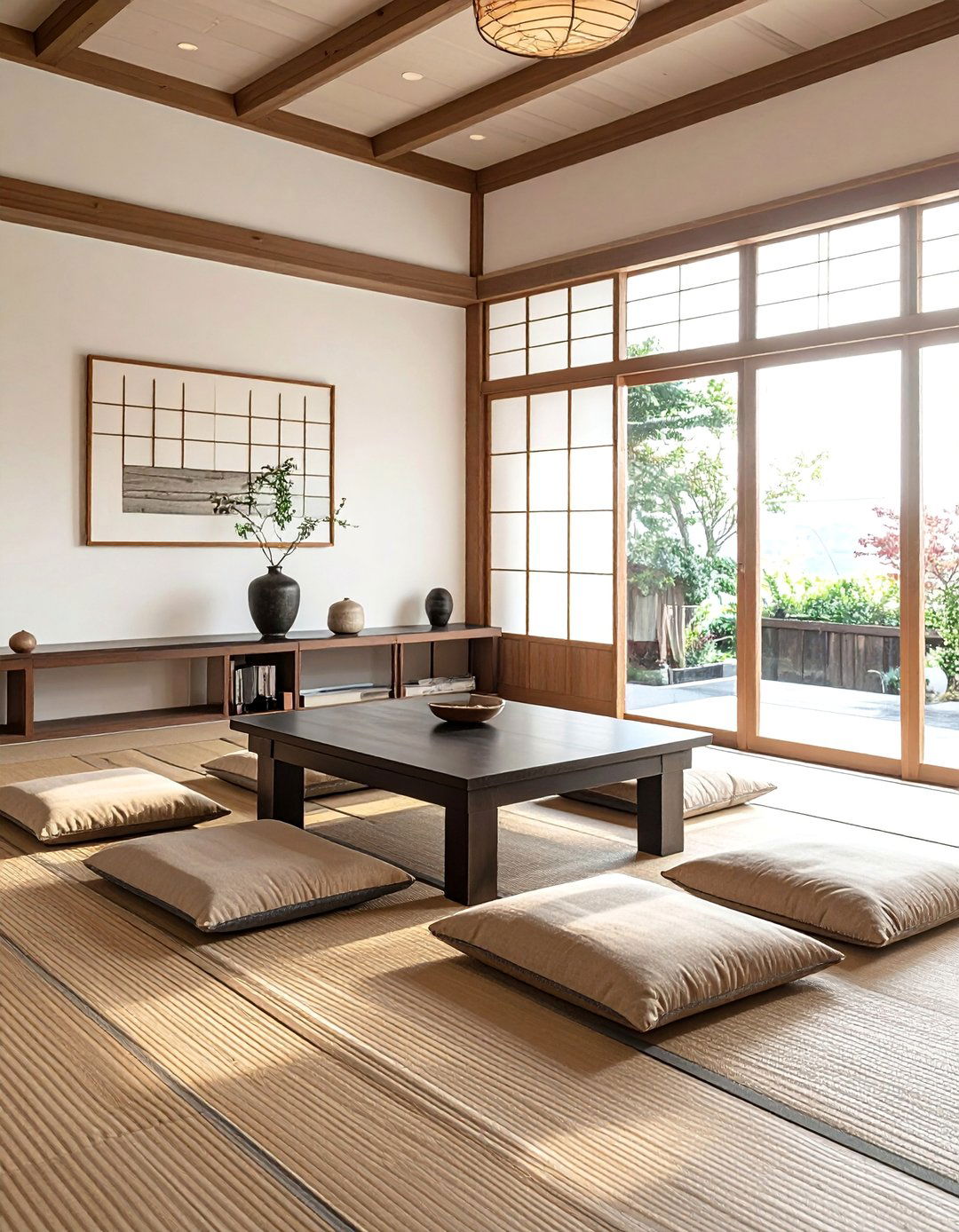
Low-profile furniture is fundamental to achieving an authentic Japanese living room aesthetic. Pieces like low tables (chabudai), floor cushions (zabuton), and simple, legless sofas (zaisu) bring the focal point of the room closer to the ground. This arrangement promotes a more relaxed and intimate atmosphere, encouraging activities like sitting on the floor for tea or conversation. By keeping furniture low, the vertical space is emphasized, making the room feel more open and spacious. This design choice reflects a lifestyle of humility and connection to the earth, creating a calming environment that is both functional and deeply rooted in tradition.
4. A Japanese Living Room with a Tokonoma Niche
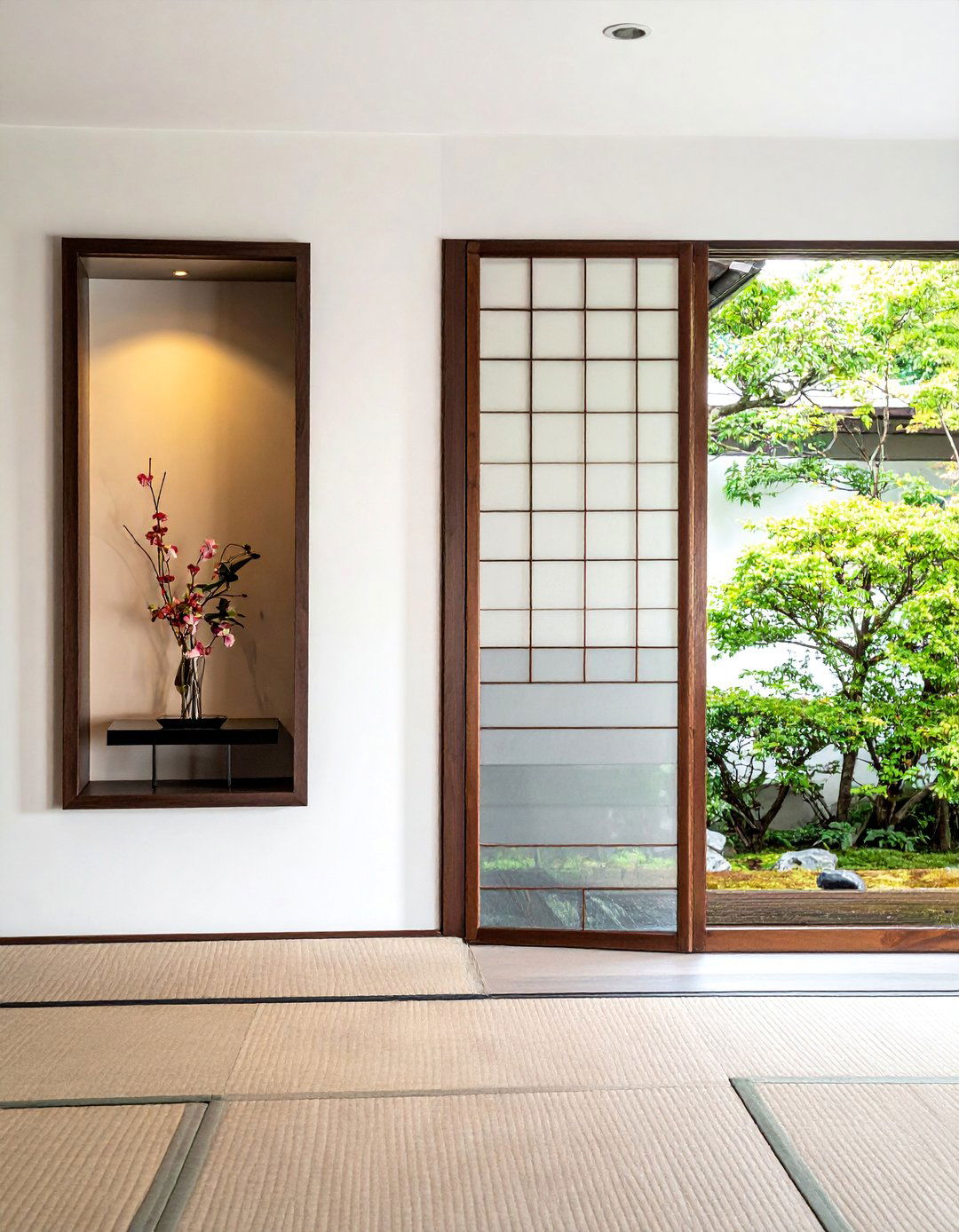
A Tokonoma is a recessed alcove that serves as the spiritual and artistic focal point of a Japanese living room. It is a dedicated space for displaying cherished items, such as a single piece of calligraphy (shodo), a beautifully arranged flower display (ikebana), or a piece of pottery. The purpose of the Tokonoma is not to showcase clutter but to highlight one or two objects of beauty and significance, encouraging contemplation and appreciation. Creating this intentional display area elevates the room's design from merely minimalist to mindfully curated, adding a layer of cultural depth and personal expression to the tranquil space.
5. Integrating an Ikebana Flower Arrangement in a Japanese Living Room
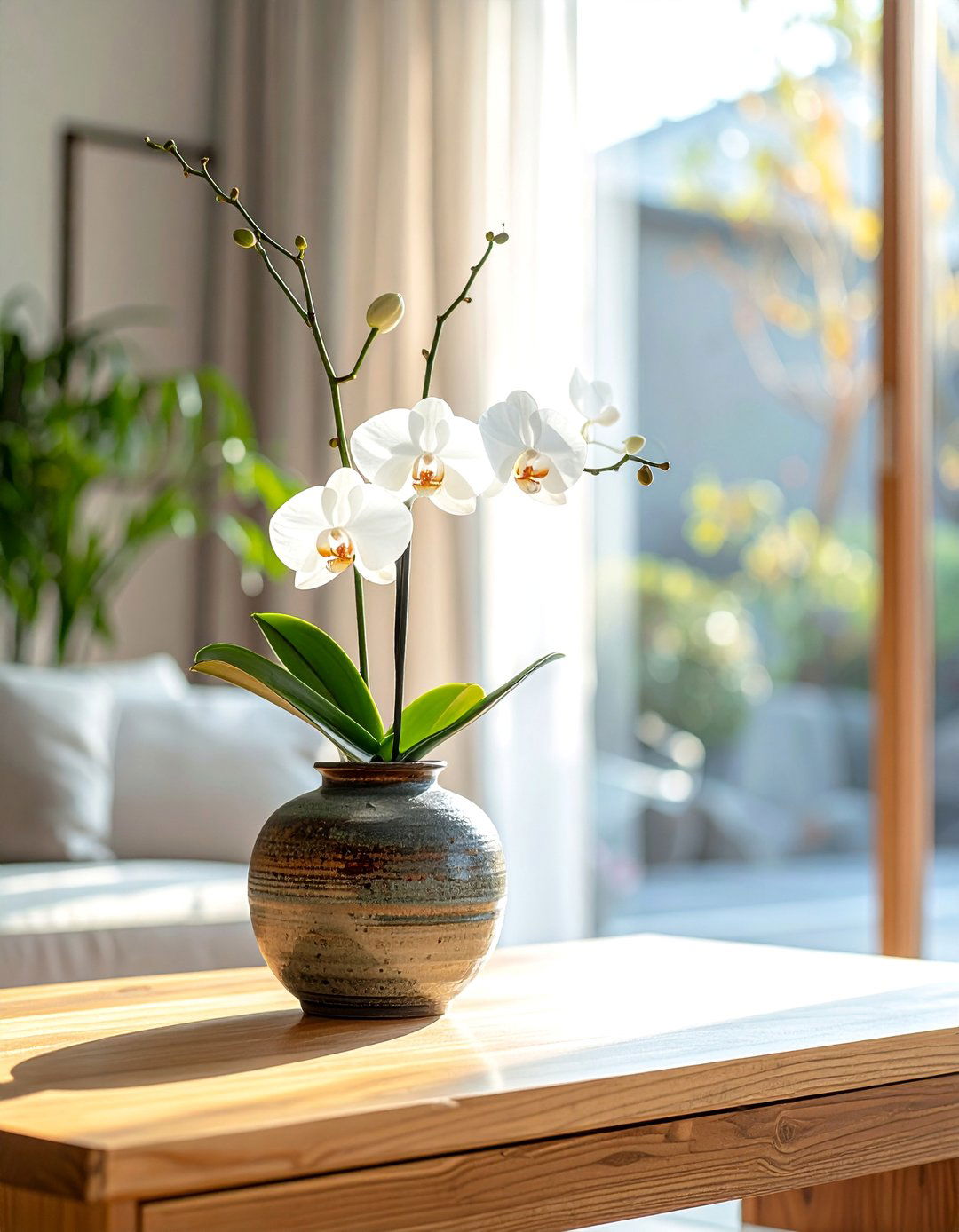
Ikebana, the Japanese art of flower arranging, is more than just decoration; it's a disciplined art form that brings nature indoors in a structured, meaningful way. Placing an Ikebana arrangement in your Japanese living room adds a touch of organic beauty and seasonality. Unlike Western floral bouquets, Ikebana emphasizes shape, line, and form, often using just a few carefully chosen stems, branches, and flowers. This minimalist approach draws attention to the simple elegance of each natural element, creating a living sculpture that changes with the seasons and fosters a sense of tranquility and connection to the natural world.
6. A Japanese Living Room Featuring Natural Wood Elements
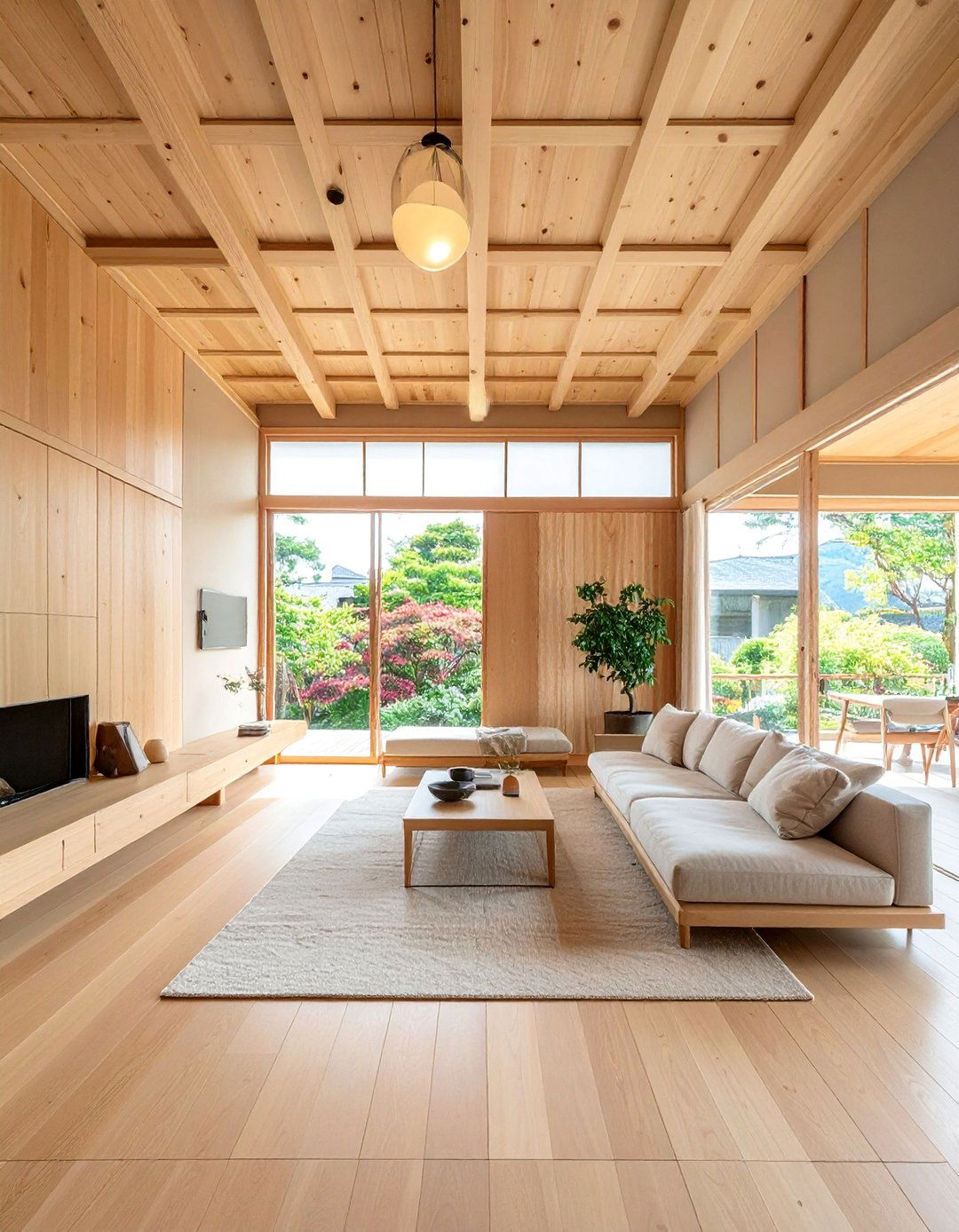
The extensive use of natural wood is a hallmark of the Japanese living room. Materials like hinoki cypress, red pine, and bamboo are celebrated for their organic warmth, subtle grain, and calming presence. Wood can be incorporated through flooring, wall paneling, ceiling beams, and furniture. The key is to keep the finishes light and natural, allowing the material's inherent beauty to shine through. This connection to nature is central to the Zen philosophy, as the presence of wood creates a grounding, peaceful environment. The clean lines and unadorned surfaces of the wooden elements contribute to the room's minimalist and harmonious feel.
7. A Neutral Color Palette for a Japanese Living Room
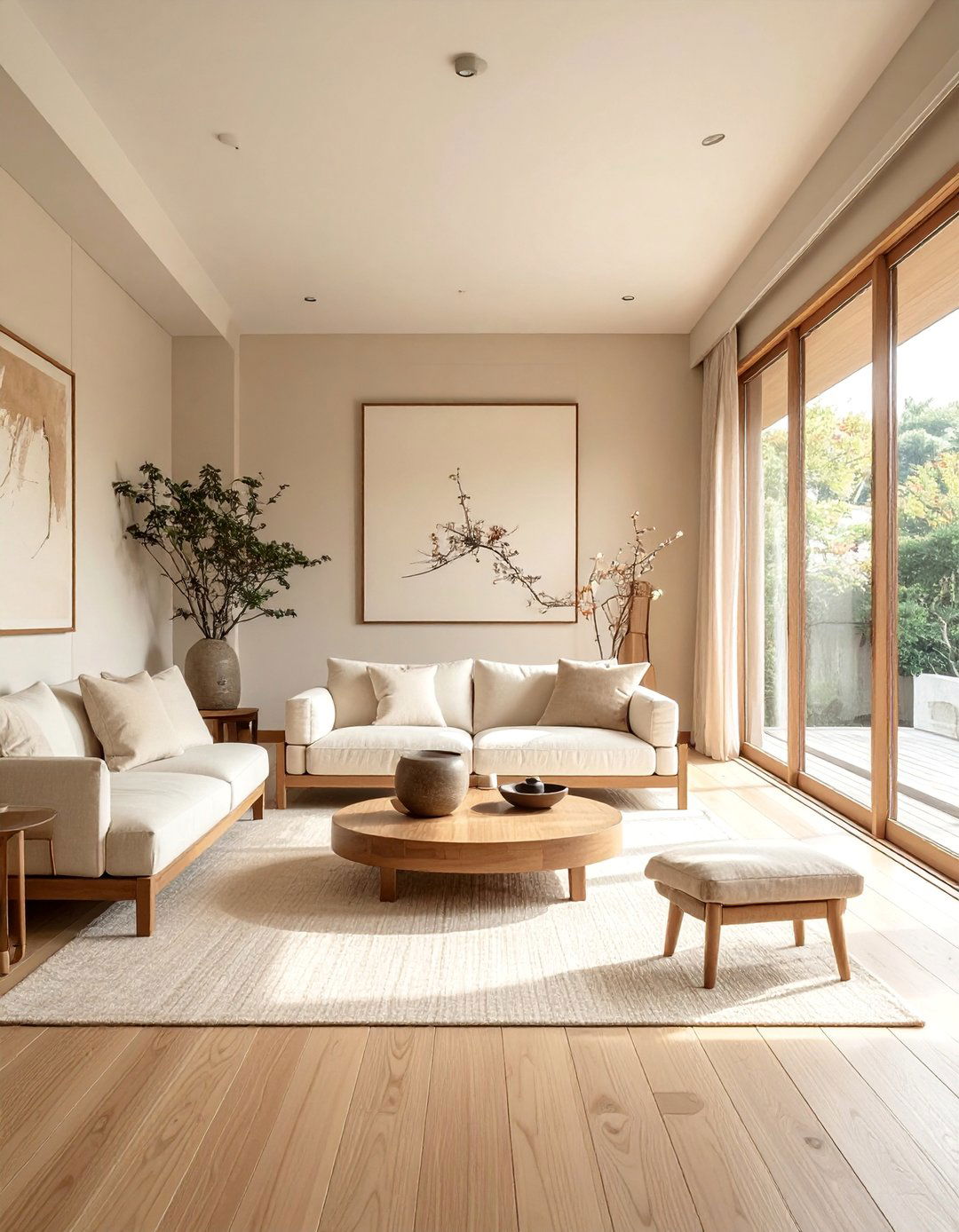
A serene and muted color palette is foundational to creating a calming Japanese living room. Drawing inspiration from nature, this scheme typically includes shades of beige, cream, soft grey, and earthy browns, accented by the green of plants and the dark tones of wood. This restrained use of color promotes a sense of peace and allows the focus to remain on the room's texture, form, and the play of light. Pops of color are used sparingly, perhaps through a single piece of art or a cushion, to add interest without overwhelming the senses. The result is a cohesive and tranquil space that feels both sophisticated and deeply restful.
8. Embracing Natural Light in a Japanese Living Room
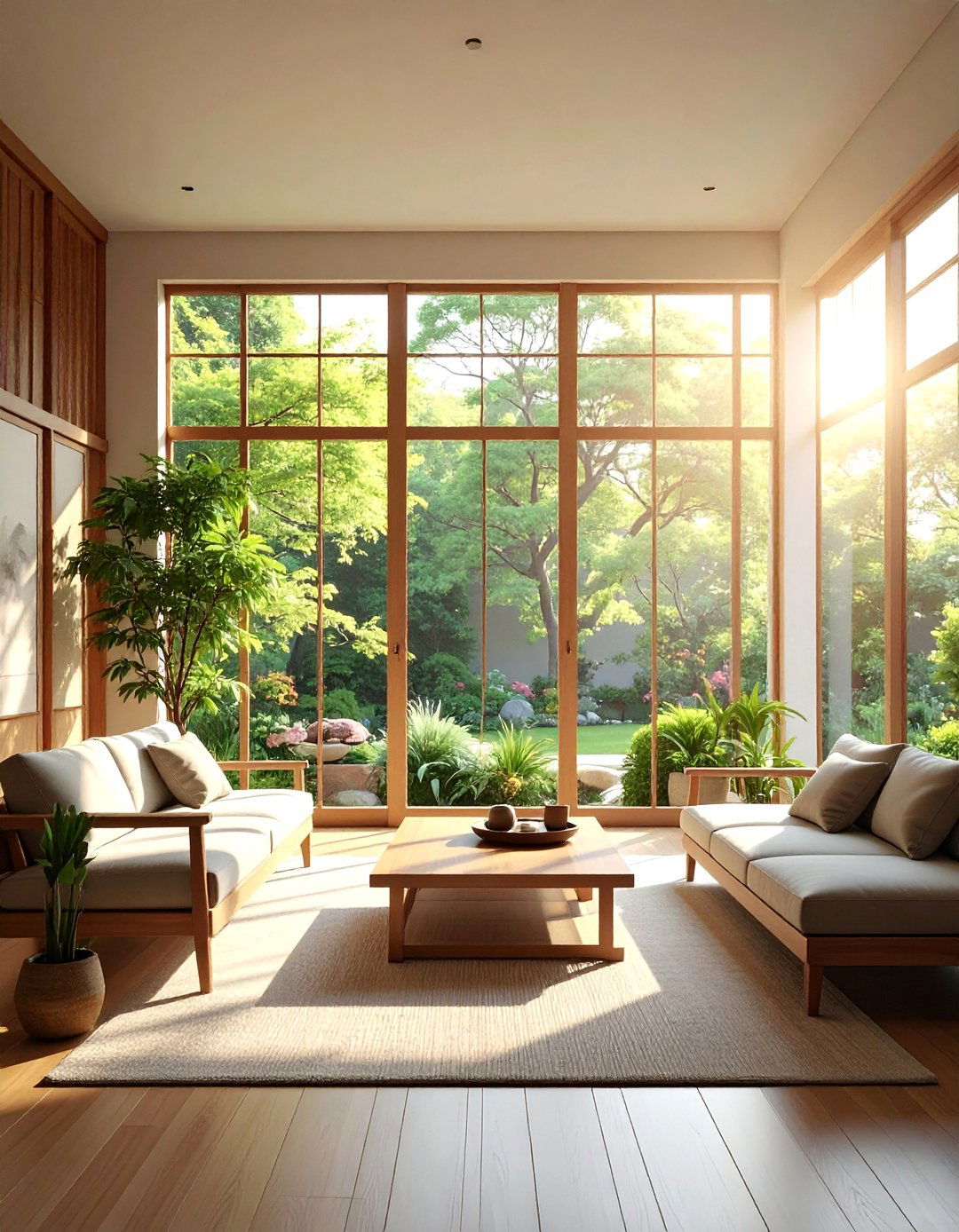
Maximizing natural light is a core principle in designing a Japanese living room. Large, unadorned windows, often covered with Shoji screens, allow soft, diffused sunlight to fill the space, creating a bright and airy atmosphere. This emphasis on light, known as "shakkei" or borrowed scenery, also serves to blur the lines between indoors and outdoors, fostering a stronger connection with nature. Keeping window treatments minimal ensures that nothing obstructs the flow of light or the view. The interplay of light and shadow throughout the day adds a dynamic, ever-changing quality to the room, enhancing its tranquil and contemplative mood.
9. Minimalist Decor in a Japanese Living Room
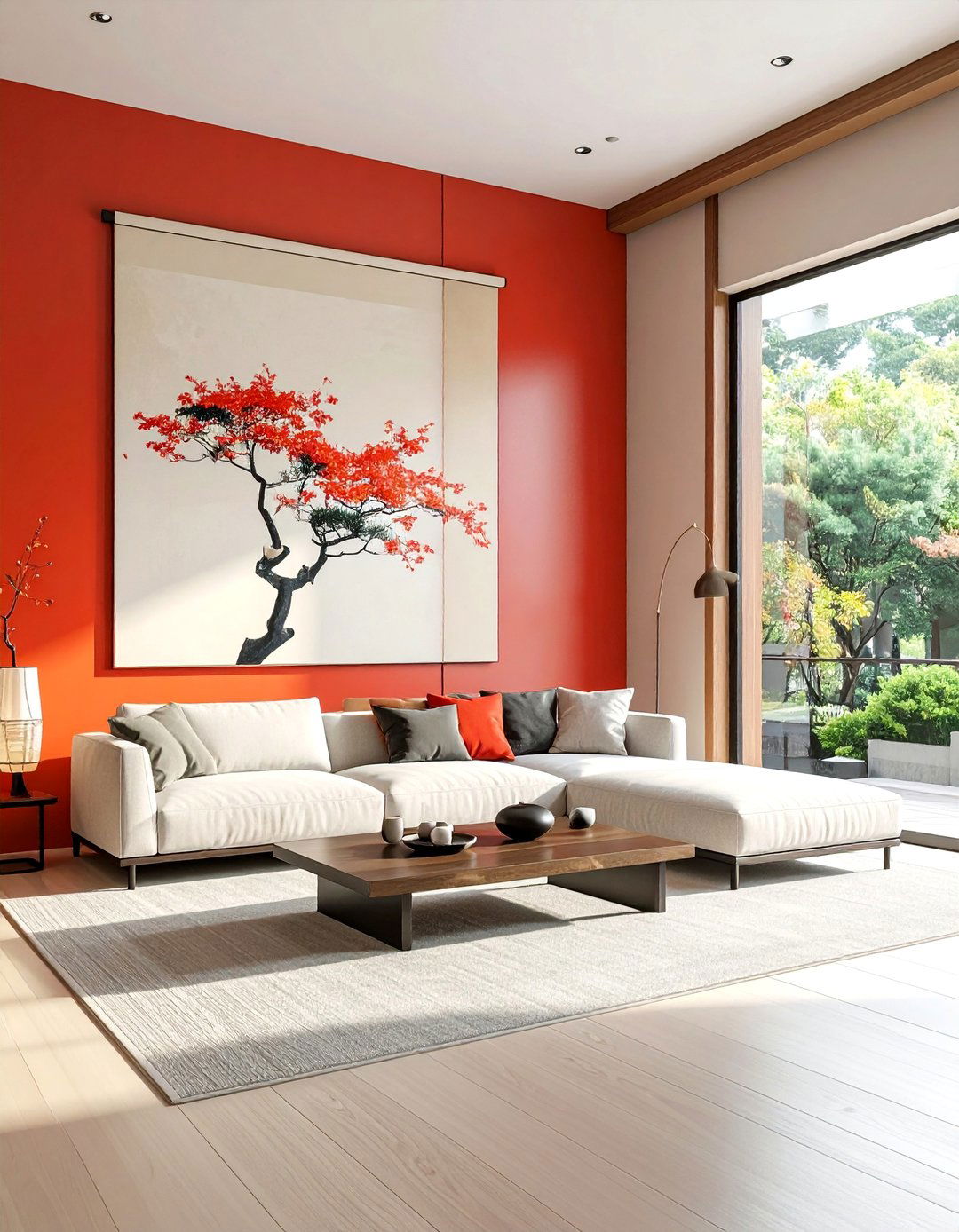
The concept of "Ma," or the beauty of empty space, is central to minimalist decor in a Japanese living room. This approach is not about deprivation but about intentionality, where every object has a purpose and a place. The room is kept free of clutter, with only a few carefully selected items on display. This could be a single scroll painting, a beautiful ceramic vase, or a sculptural floor lamp. By paring back to the essentials, you create a sense of order and calm, allowing the mind to rest. This deliberate simplicity highlights the beauty of the room's architecture, materials, and the few chosen decorative pieces.
10. A Japanese Living Room with an Indoor Zen Garden
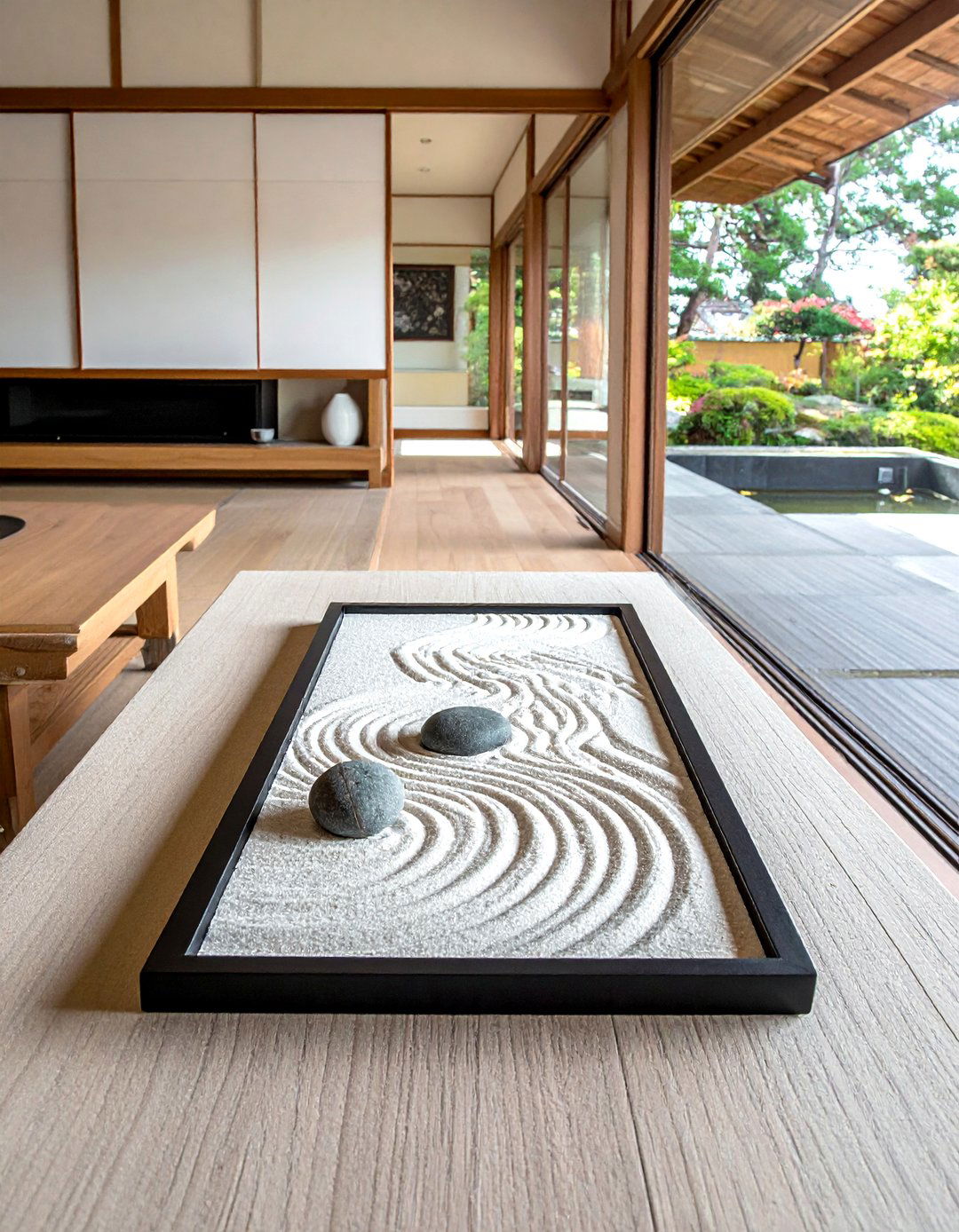
Bringing a small Zen garden, or "karesansui," into your Japanese living room is a powerful way to cultivate tranquility. These miniature landscapes, typically composed of sand or gravel raked to represent water, along with carefully placed rocks symbolizing islands or mountains, serve as a focus for meditation and contemplation. An indoor Zen garden can be a small tabletop feature or a larger, dedicated corner of the room. The act of raking the sand can be a meditative practice in itself, while its minimalist beauty adds a profound sense of peace and natural artistry to the space.
11. Seamless Indoor-Outdoor Connection in a Japanese Living Room
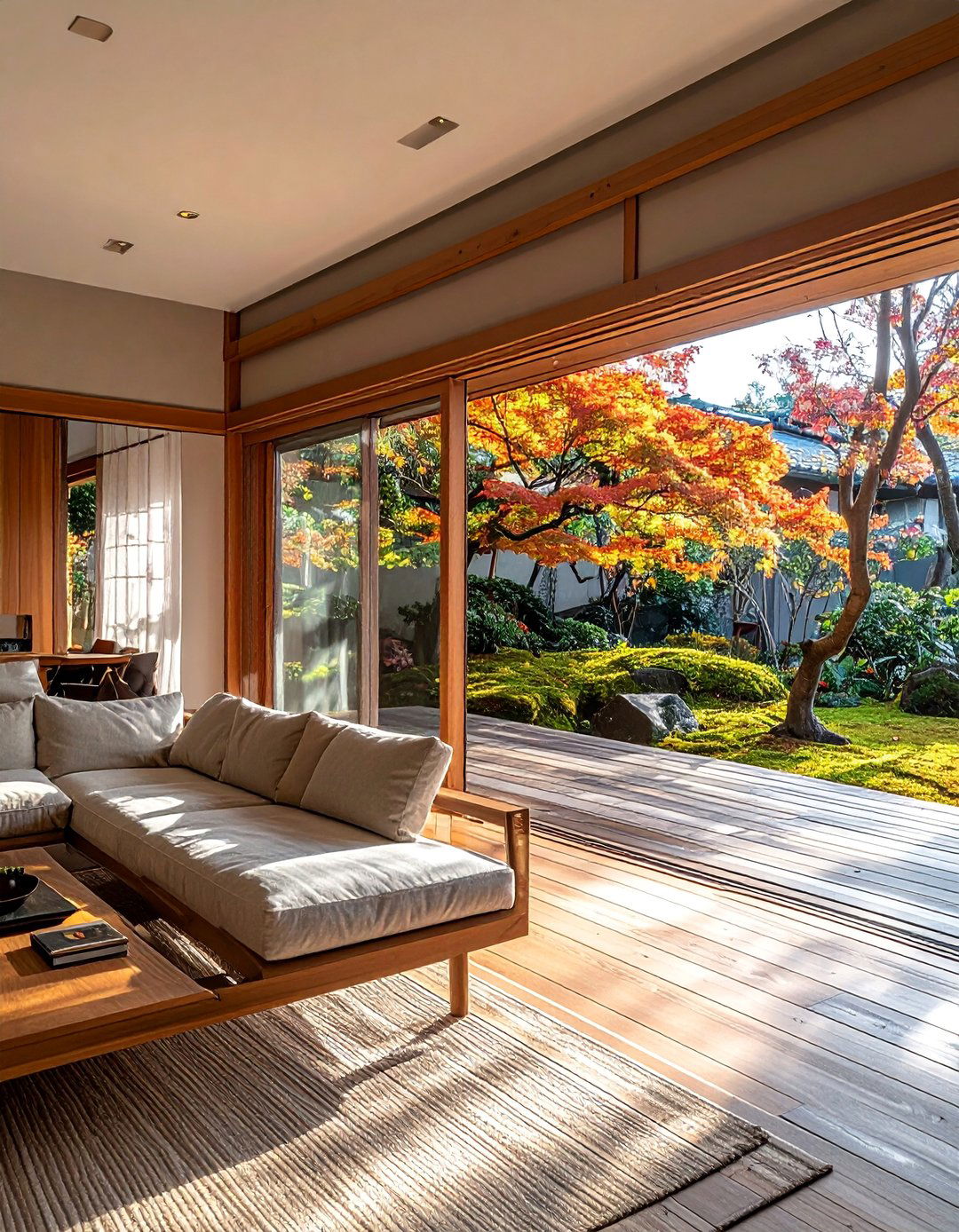
Creating a seamless flow between the indoors and outdoors is a defining feature of Japanese architecture and is perfectly suited for a living room. This is often achieved with large sliding glass doors or floor-to-ceiling windows that open onto a garden, patio, or balcony. Using similar flooring materials both inside and out can further blur the distinction. This design philosophy, known as "shakkei," or borrowed scenery, incorporates the natural landscape as part of the room's decor. The result is a living space that feels expansive, filled with natural light, and deeply connected to the changing seasons and the beauty of the outdoors.
12. Using Bamboo Elements in a Japanese Living Room
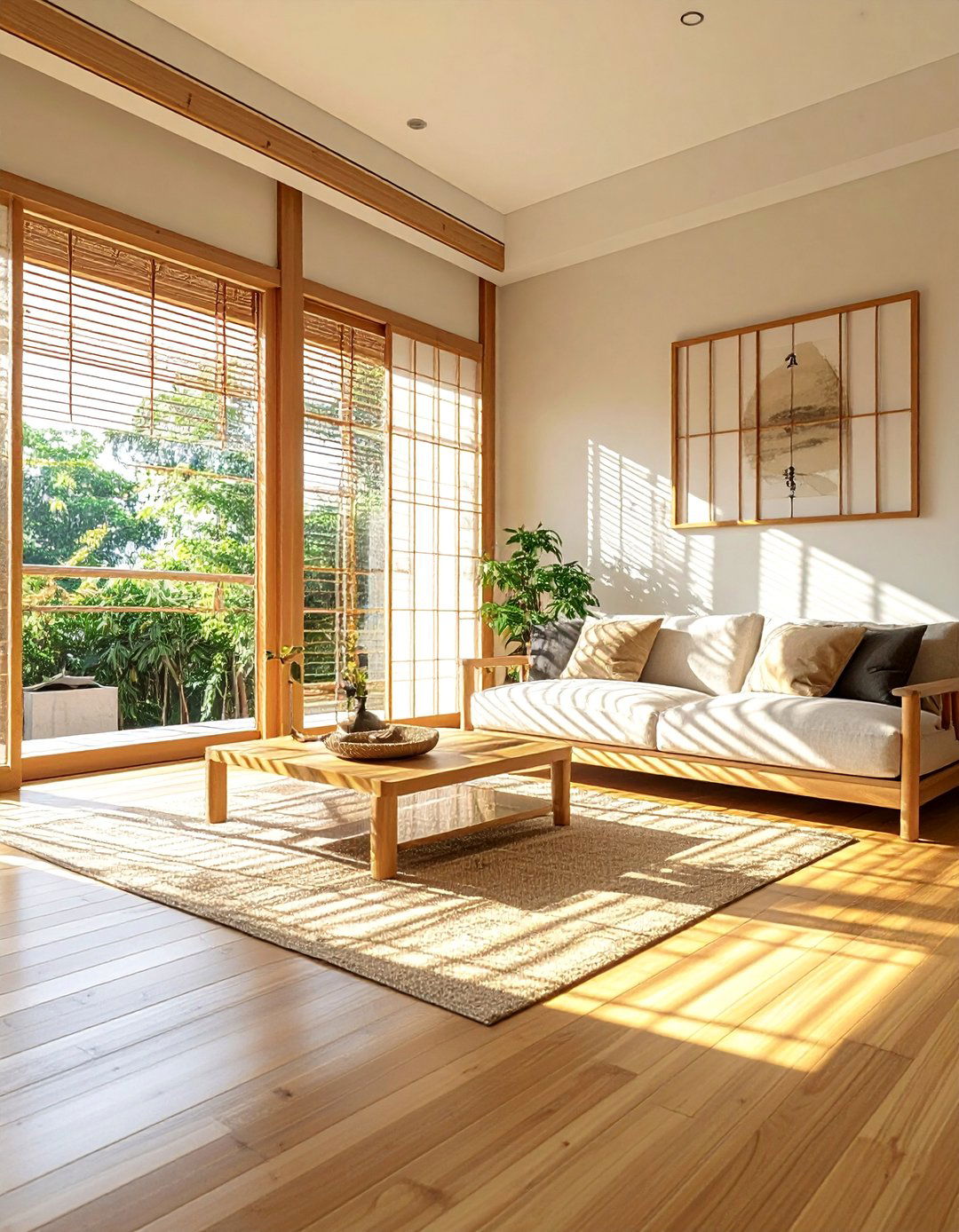
Bamboo is a versatile and sustainable material that brings a distinct touch of nature into a Japanese living room. Its clean lines and organic texture make it ideal for a variety of applications, from flooring and wall coverings to furniture and decorative accents. A bamboo floor adds warmth and durability, while bamboo blinds offer a natural way to filter light. Even small touches, like a bamboo vase, a decorative ladder, or a live bamboo plant in a simple pot, can reinforce the Zen aesthetic. Its presence adds a layer of tranquility and reinforces the design's commitment to natural, eco-friendly materials.
13. A Japanese Living Room with a Low Tea Table
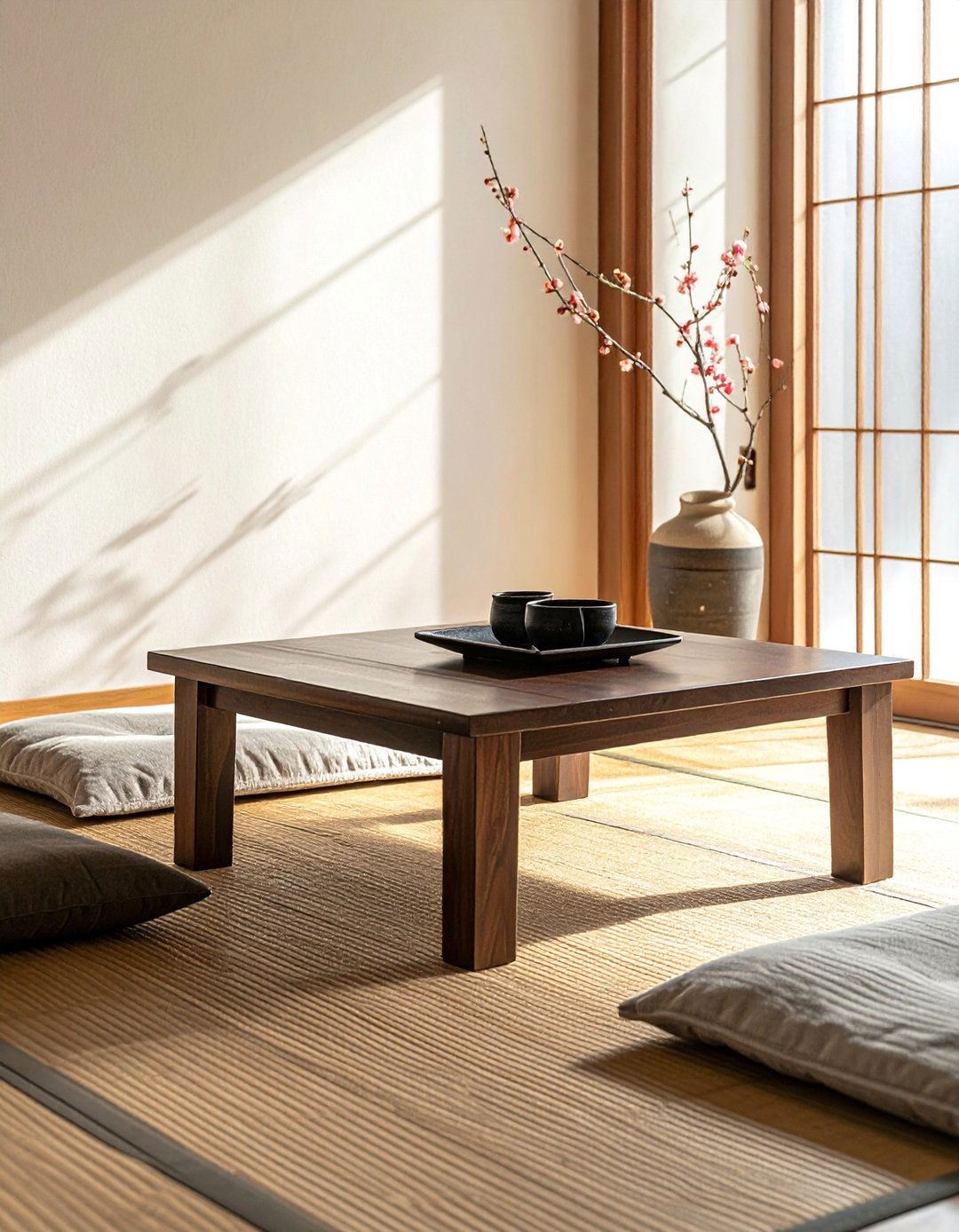
The "chabudai," a short-legged table, is a central piece of furniture in a traditional Japanese living room. It serves as a communal hub for sharing tea, meals, and conversation while sitting on "zabuton" floor cushions. Its low height encourages a relaxed, grounded posture and fosters a sense of intimacy among those gathered around it. In a modern setting, a chabudai can be a beautifully crafted wooden centerpiece that anchors the seating area. Its simple, functional design embodies the minimalist principles of Japanese aesthetics, creating an inviting focal point that is both practical and culturally significant.
14. Integrated and Concealed Storage in a Japanese Living Room
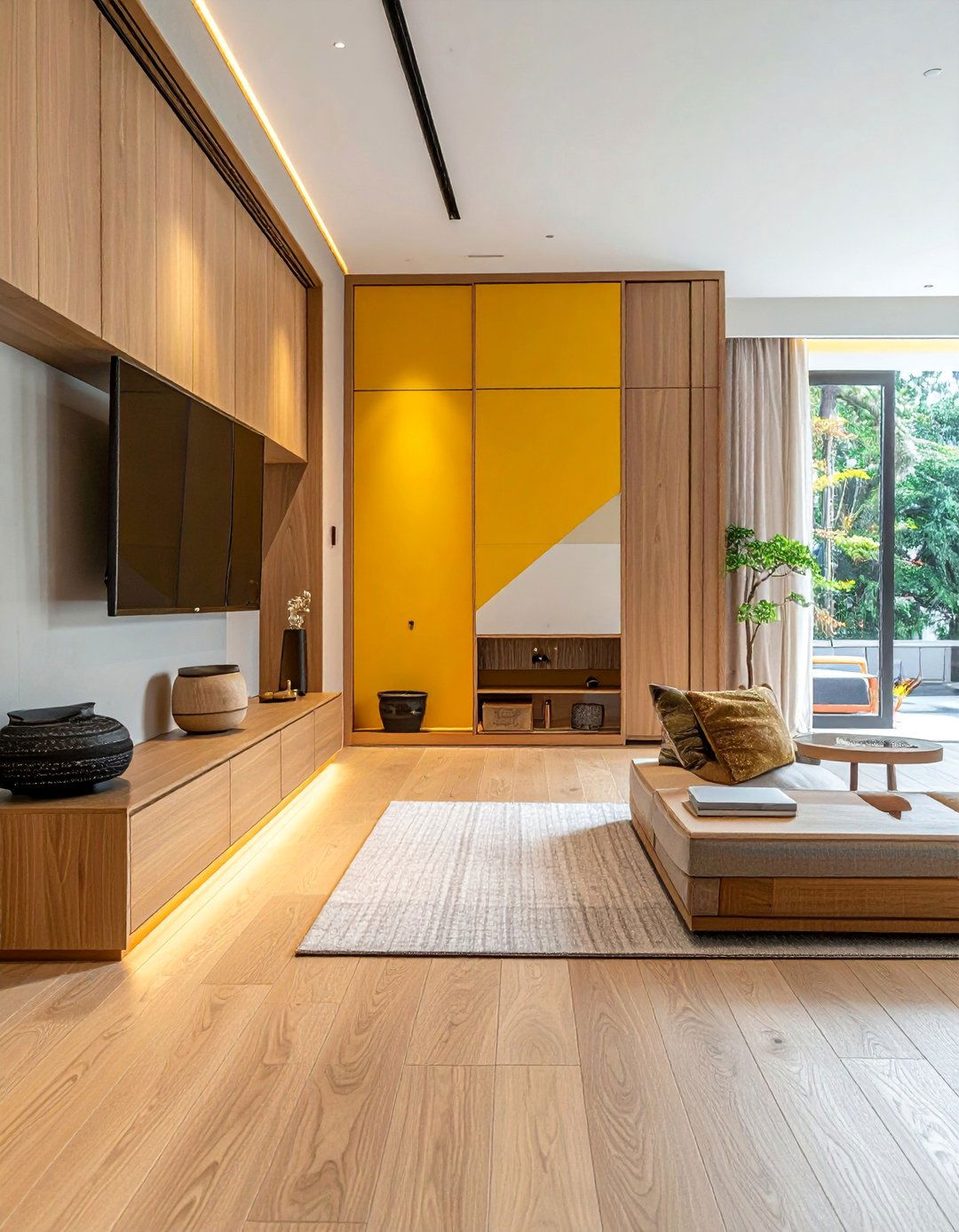
Maintaining a clutter-free environment is essential in a Japanese living room, making integrated and concealed storage solutions a key design feature. Built-in wall units, closets with simple, unadorned doors, and multi-functional furniture like storage ottomans or platform beds with drawers help keep belongings out of sight. The goal is to create smooth, uninterrupted surfaces that contribute to the room's serene and spacious feel. By cleverly hiding away everyday items, the focus remains on the room's clean lines, natural materials, and carefully chosen decorative elements, preserving the peaceful and organized atmosphere that defines Zen-inspired design.
15. A Japanese Living Room with Wabi-Sabi Principles
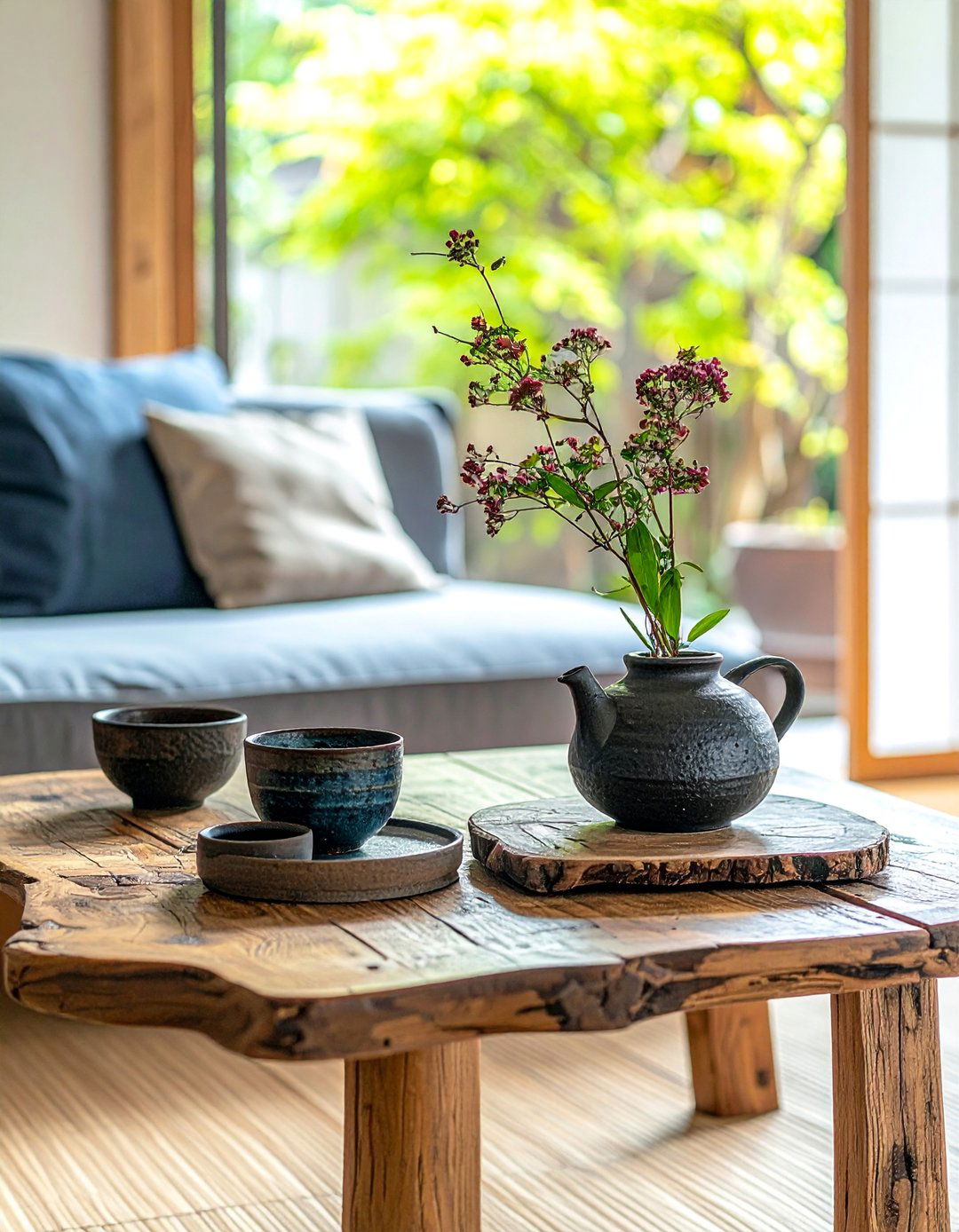
Embracing the Wabi-Sabi philosophy in your Japanese living room means finding beauty in imperfection, impermanence, and authenticity. This concept celebrates natural materials that age gracefully, such as weathered wood, rustic pottery, and handwoven textiles. Instead of striving for a flawless, sterile look, Wabi-Sabi encourages the inclusion of objects with history and character—a slightly irregular ceramic bowl, a piece of driftwood, or a linen throw with natural creases. This approach creates a space that feels grounded, soulful, and deeply comforting, reminding us to appreciate the simple, transient beauty of everyday life and nature itself.
16. A Japanese Living Room with a Kotatsu Table
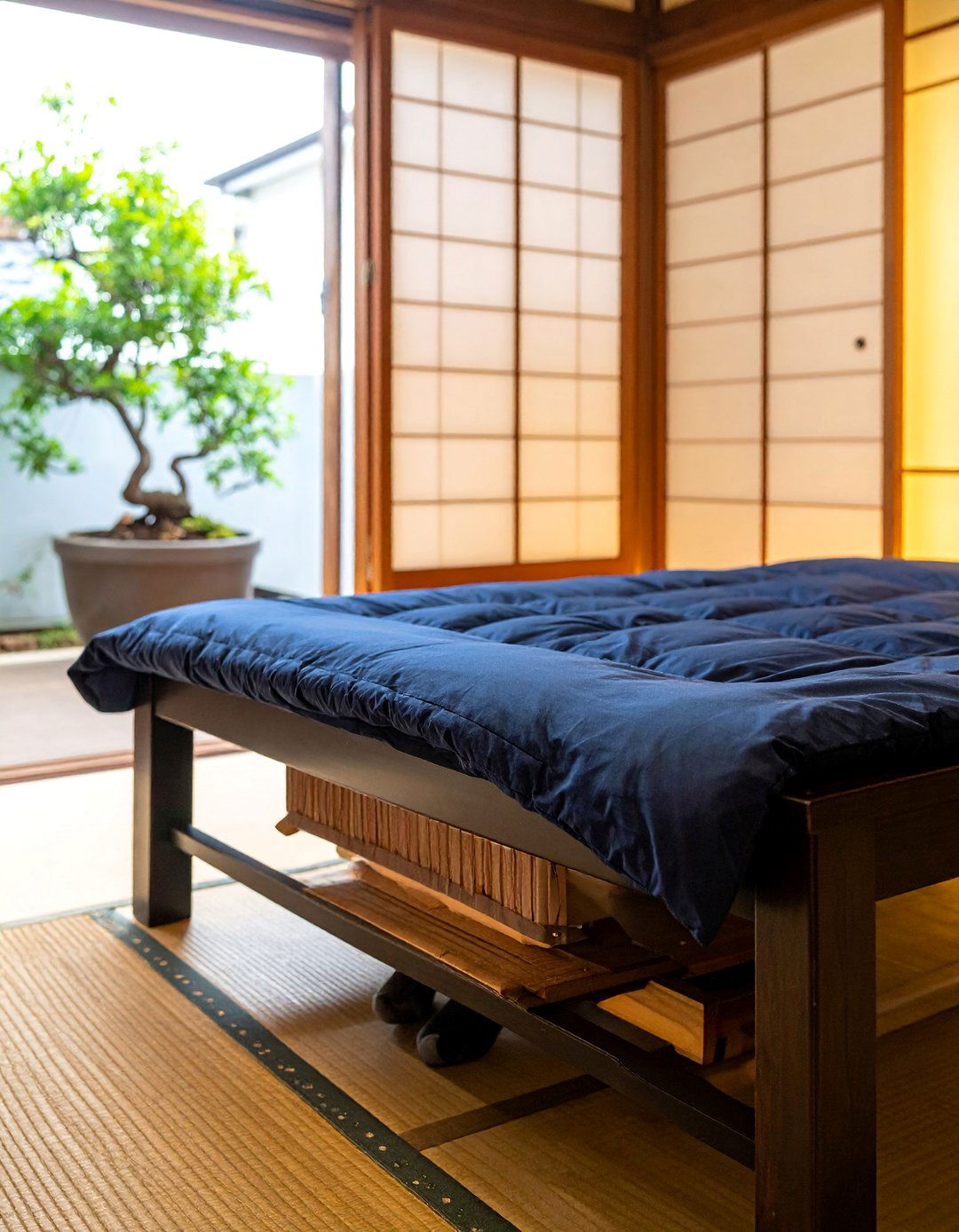
For a cozy and functional centerpiece, especially in cooler climates, a kotatsu is a wonderful addition to a Japanese living room. This unique piece of furniture is a low table with a built-in heater underneath and a heavy blanket or futon placed over the frame to trap the warmth. Family and guests can sit on the floor with their legs tucked under the blanket, creating a warm, communal gathering spot. The kotatsu embodies the Japanese value of shared comfort and togetherness. When not in use as a heater, it functions perfectly as a standard low table, making it a practical and inviting element in the room.
17. The Art of Asymmetry in a Japanese Living Room
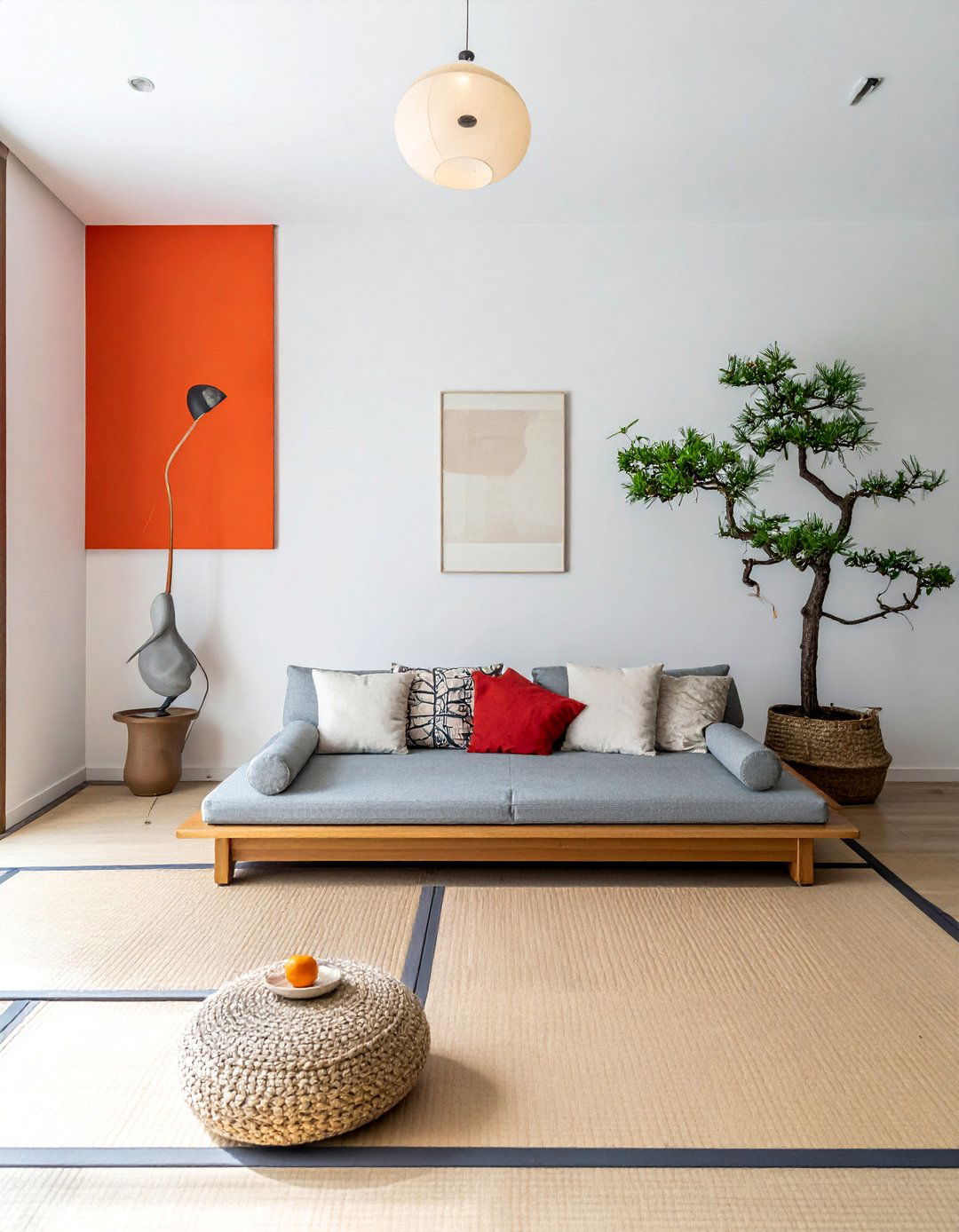
Unlike the strict symmetry often found in Western design, Japanese aesthetics frequently embrace asymmetry ("fukinsei") to create balance and interest. In a Japanese living room, this principle can be applied by arranging furniture or decor in a way that feels natural and dynamic rather than rigid and formal. For example, a piece of art might be placed slightly off-center on a wall, or a group of three decorative objects of varying heights could be placed on a shelf. This approach mirrors the organic balance found in nature, resulting in a composition that is visually engaging, harmonious, and calming.
18. Japanese Living Room with Paper Lantern Lighting
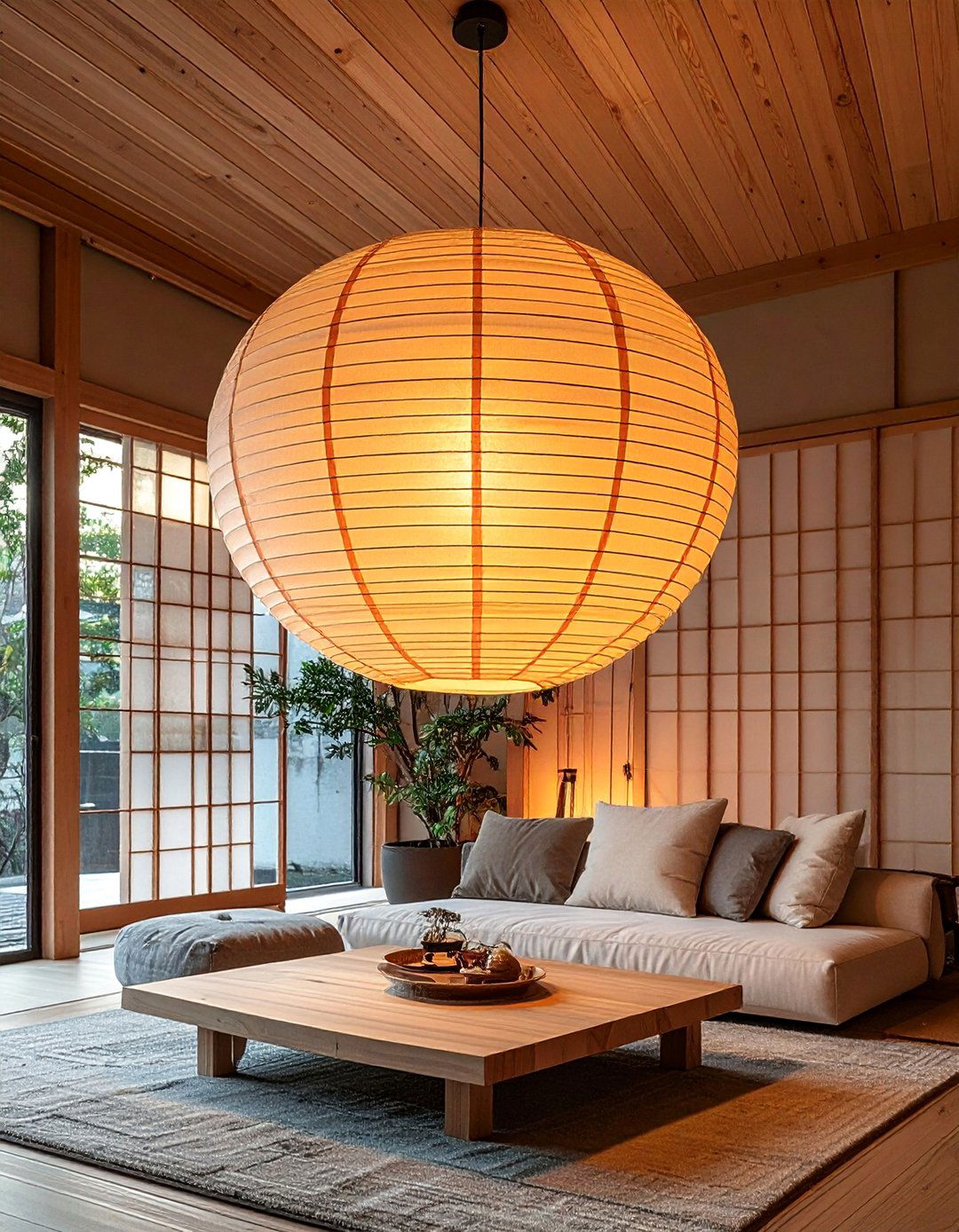
Lighting plays a crucial role in setting the mood of a Japanese living room, and paper lanterns ("andon" or "chochin") are a classic choice for creating a soft, warm, and inviting glow. Made from washi paper stretched over a bamboo or wood frame, these fixtures diffuse light gently, eliminating harsh shadows and contributing to a serene ambiance. They can be used as floor lamps, table lamps, or pendant lights. Their simple, sculptural forms add an element of artistic elegance to the room while providing functional illumination. The gentle light they cast is perfect for creating a relaxing and contemplative atmosphere in the evening.
19. Incorporating Water Features in a Japanese Living Room
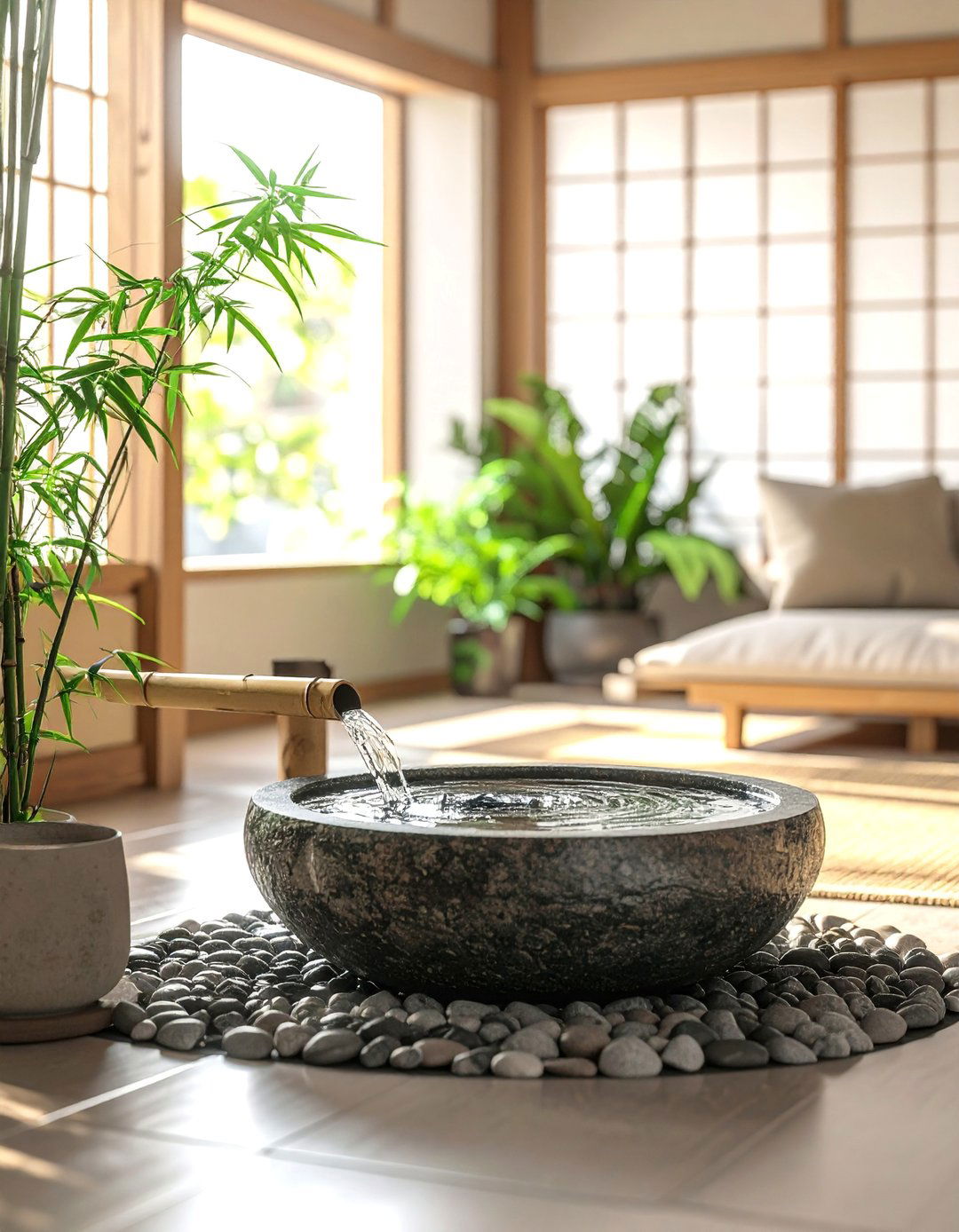
A small indoor water feature can be a powerful tool for cultivating a Zen atmosphere in a Japanese living room. The gentle sound of trickling water has a naturally calming effect, helping to mask distracting background noise and promote a sense of peace and meditation. This could be a small tabletop fountain made of stone or bamboo, or a more integrated feature like a small indoor pond or basin. The presence of water, a key element in Japanese gardens, reinforces the connection to nature and adds a sensory layer to the room that enhances its tranquility and helps to purify the air.
20. A Japanese Living Room with Stone and Rock Accents
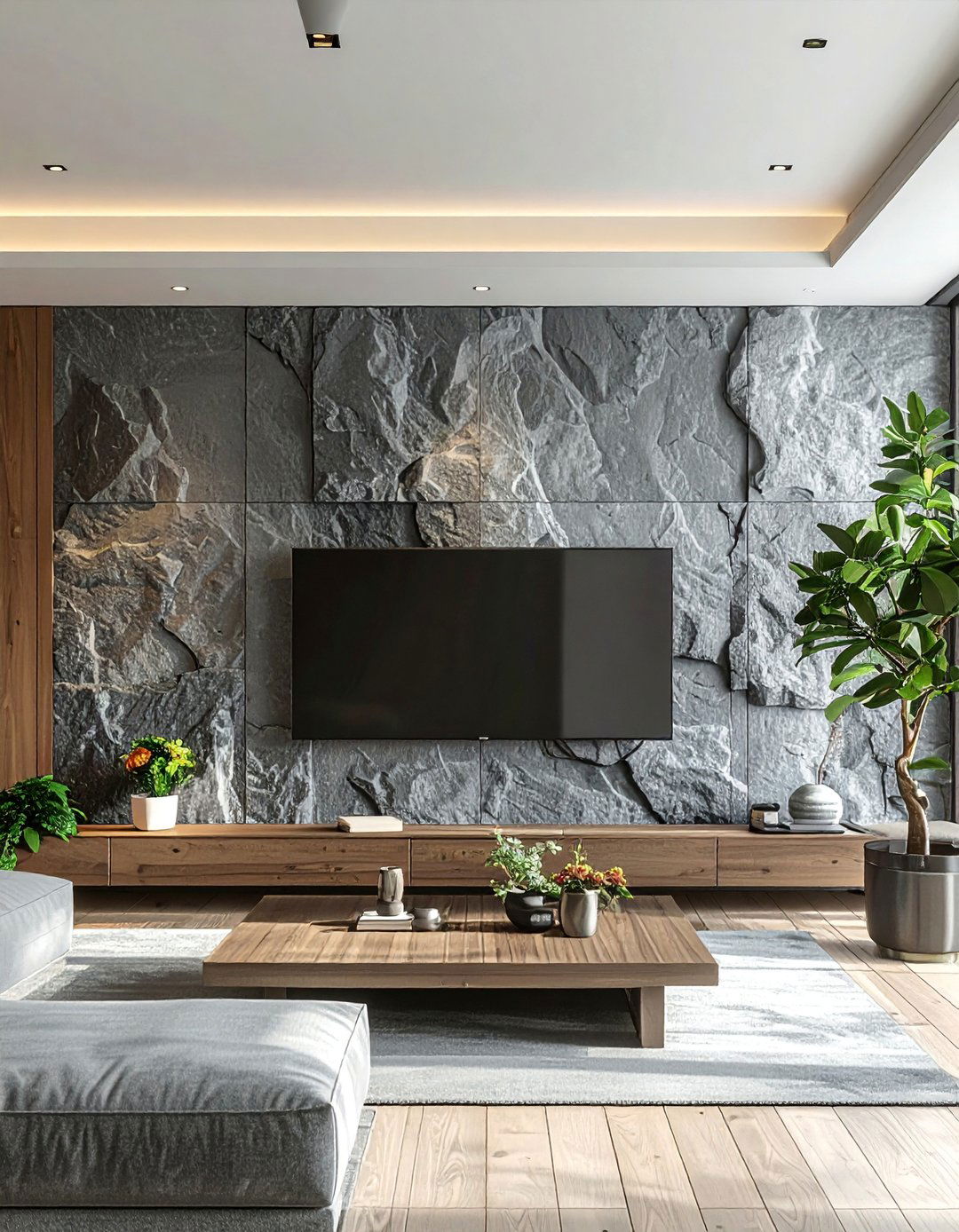
Incorporating natural stone and rock brings a grounding, earthy element into a Japanese living room. This can be achieved through a feature wall of stacked stone, a collection of smooth river rocks arranged in a tray, or a large, sculptural rock used as a decorative accent. Stone represents permanence, stability, and the enduring power of nature. Its rugged texture provides a beautiful contrast to the smooth surfaces of wood and paper. These elements, often used in Zen gardens to symbolize mountains, add a sense of timelessness and strength to the space, further deepening its connection to the natural world.
21. Use of Fusuma Sliding Doors in a Japanese Living Room
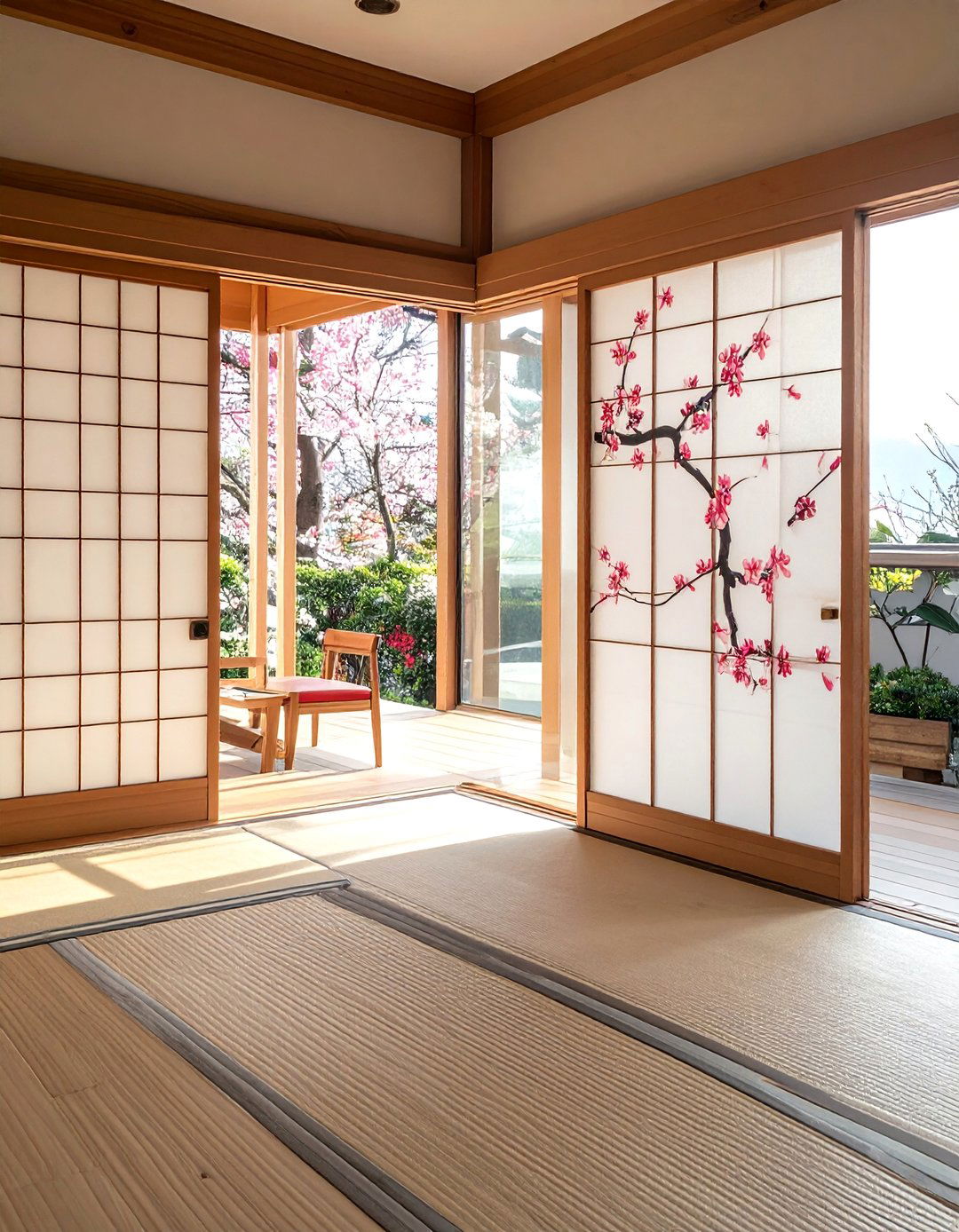
Fusuma are opaque sliding panels, often made of paper or cloth on a wooden lattice, used to redefine spaces within a Japanese home. In a living room, they can function as closet doors or as partitions to separate it from an adjoining room. Unlike hinged doors, fusuma slide effortlessly, saving space and creating a sense of fluidity and adaptability. They are often decorated with beautiful, subtle paintings of natural scenes like landscapes, animals, or plants, turning a functional element into a large-scale piece of art. This adds a layer of traditional elegance and artistic expression to the minimalist aesthetic.
22. Focus on Craftsmanship in a Japanese Living Room
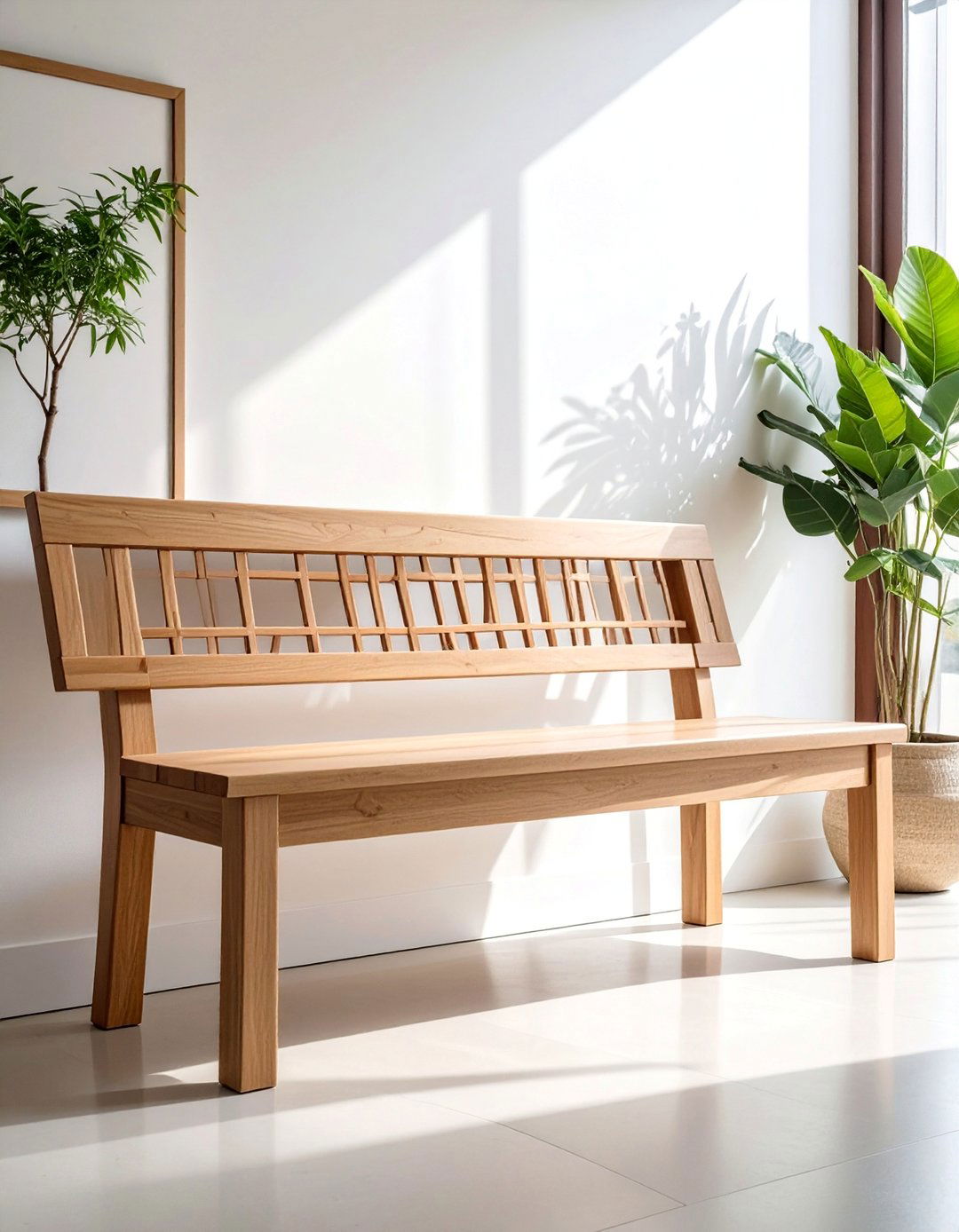
Japanese design places a high value on craftsmanship ("shokunin"), celebrating the skill and dedication of the artisan. This principle can be reflected in your living room by choosing pieces of furniture and decor that are well-made from high-quality materials. A hand-crafted wooden table with intricate joinery, a piece of hand-thrown pottery, or a finely woven textile can become a focal point. These items not only add beauty and functionality but also bring a sense of soul and history to the space. Investing in pieces made with care and precision aligns with the Zen philosophy of appreciating quality, simplicity, and enduring value.
23. A Japanese Living Room with Platform Seating
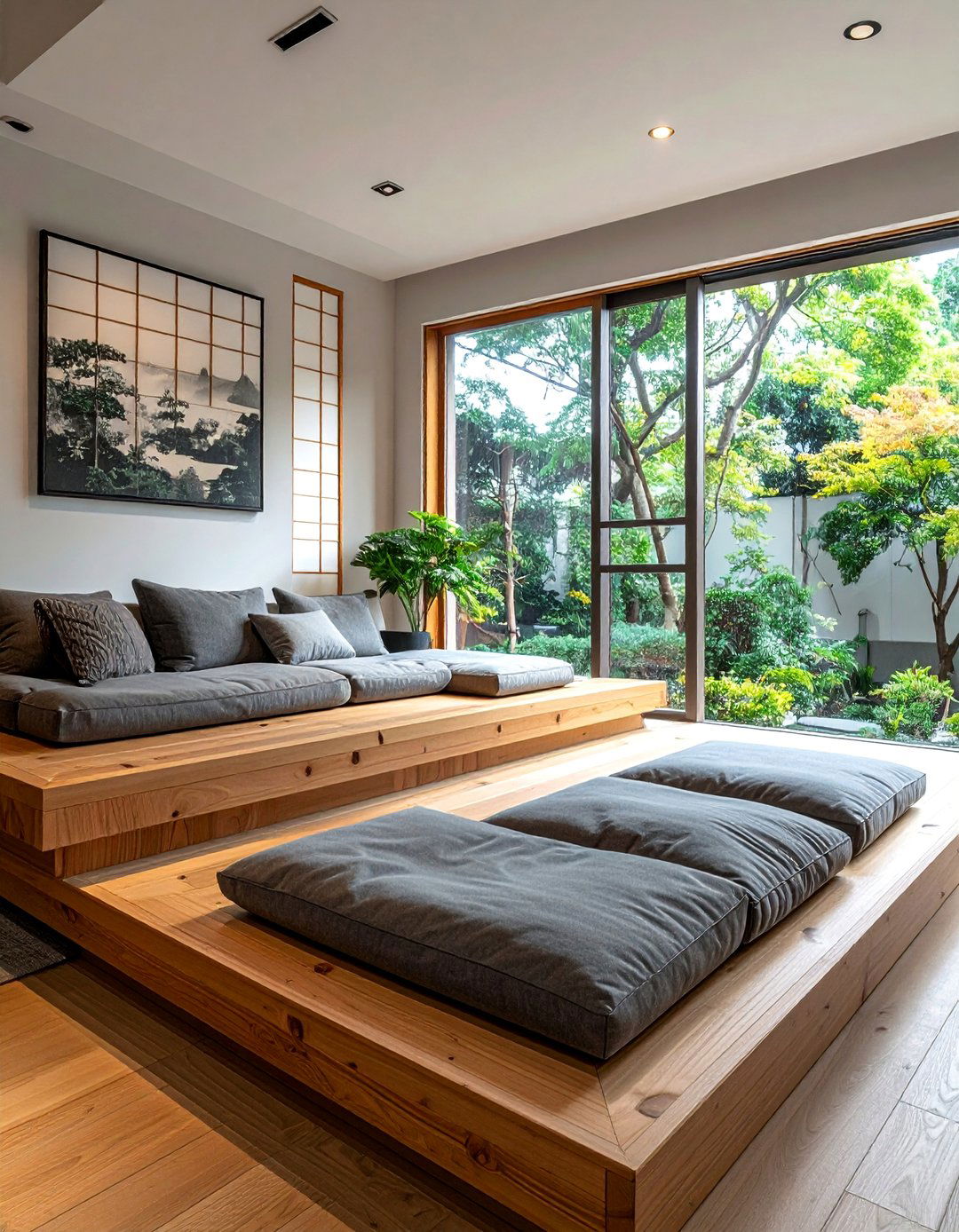
Platform seating is a modern interpretation of the traditional floor-level lifestyle found in a Japanese living room. This can be a low, built-in wooden platform that runs along a wall, topped with comfortable cushions for seating. It creates a defined, cozy nook for relaxing, reading, or socializing. The platform itself can incorporate hidden storage underneath, maintaining the room's clutter-free appearance. This architectural feature adds a dynamic level to the room's layout while preserving the low-to-the-ground orientation. It's a stylish and practical way to blend traditional principles with contemporary comfort and functionality for a modern home.
24. A Japanese Living Room with Calligraphy Art
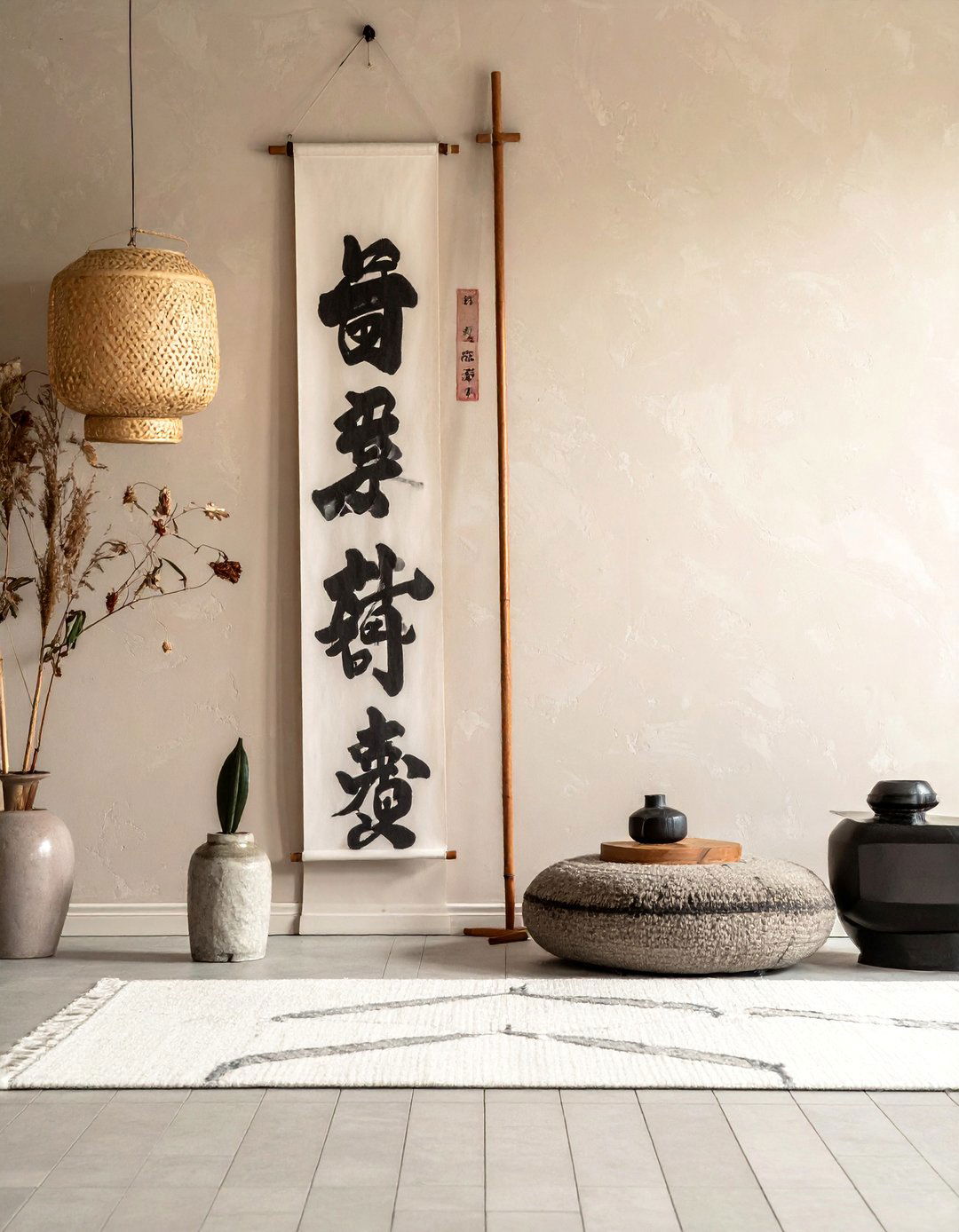
Displaying Japanese calligraphy ("shodo") is a classic way to add a touch of artistic and philosophical depth to your living room. A single, beautifully rendered scroll hanging in the Tokonoma or on a prominent wall can be a powerful statement piece. The characters often represent concepts central to Zen philosophy, such as "peace," "harmony," or "simplicity." The bold, fluid brushstrokes provide a strong graphic contrast to the room's otherwise serene and muted tones. This art form is not just decorative; it's a meditative practice that embodies balance, control, and the beauty of a single, expressive moment.
25. A Japanese Living Room with Views of a Japanese Garden
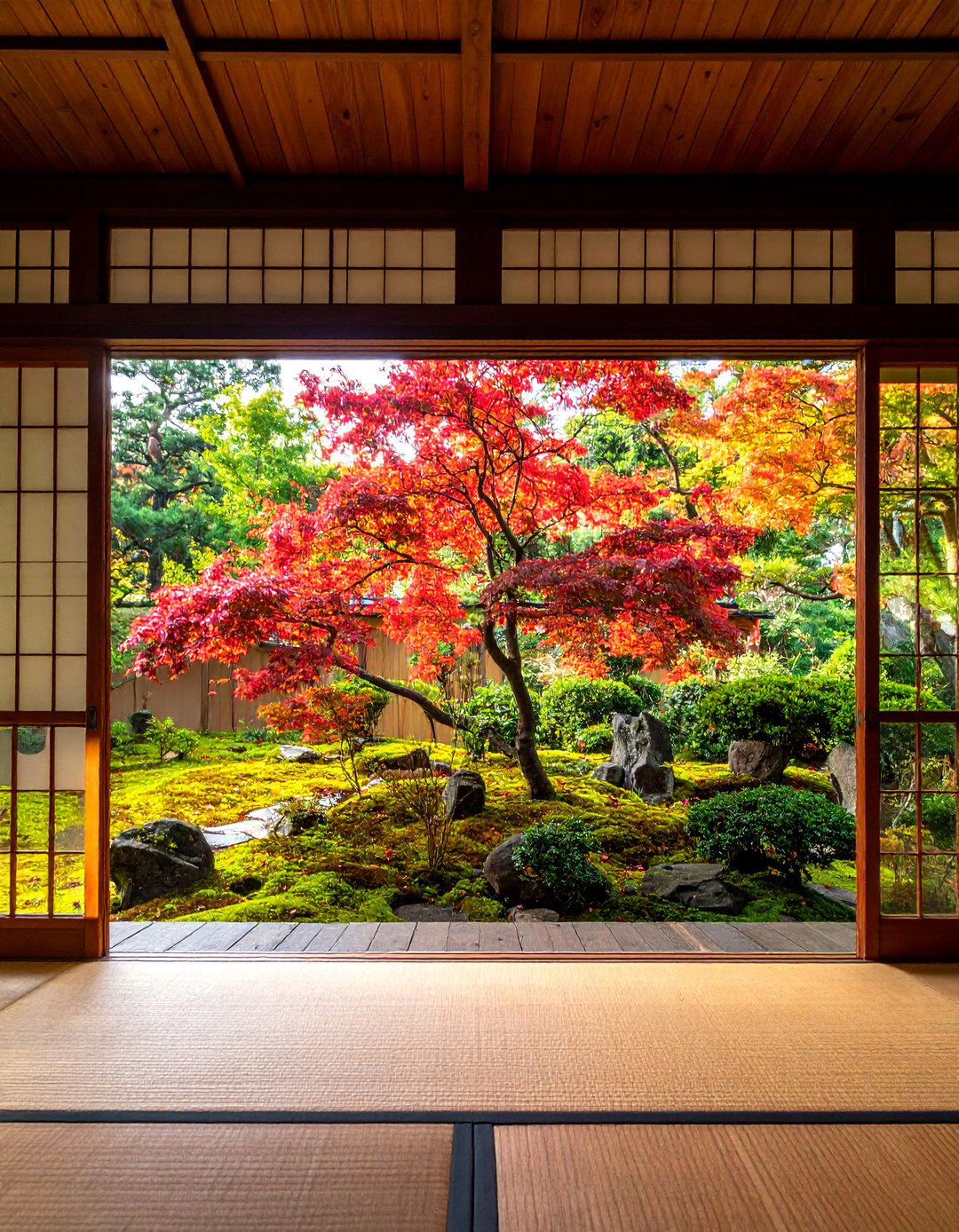
If possible, designing your Japanese living room to overlook a Japanese garden creates the ultimate indoor-outdoor sanctuary. Large windows or sliding glass doors that frame the view act as living artwork that changes with the light and seasons. The garden itself, with its carefully placed rocks, water features, pruned trees, and moss, is an extension of the room's Zen philosophy. This direct visual connection to nature is incredibly calming and restorative. The "borrowed scenery" becomes the primary decor, filling the room with a sense of peace, beauty, and harmony that no man-made object can fully replicate.
26. Incorporating Byobu Folding Screens in a Japanese Living Room
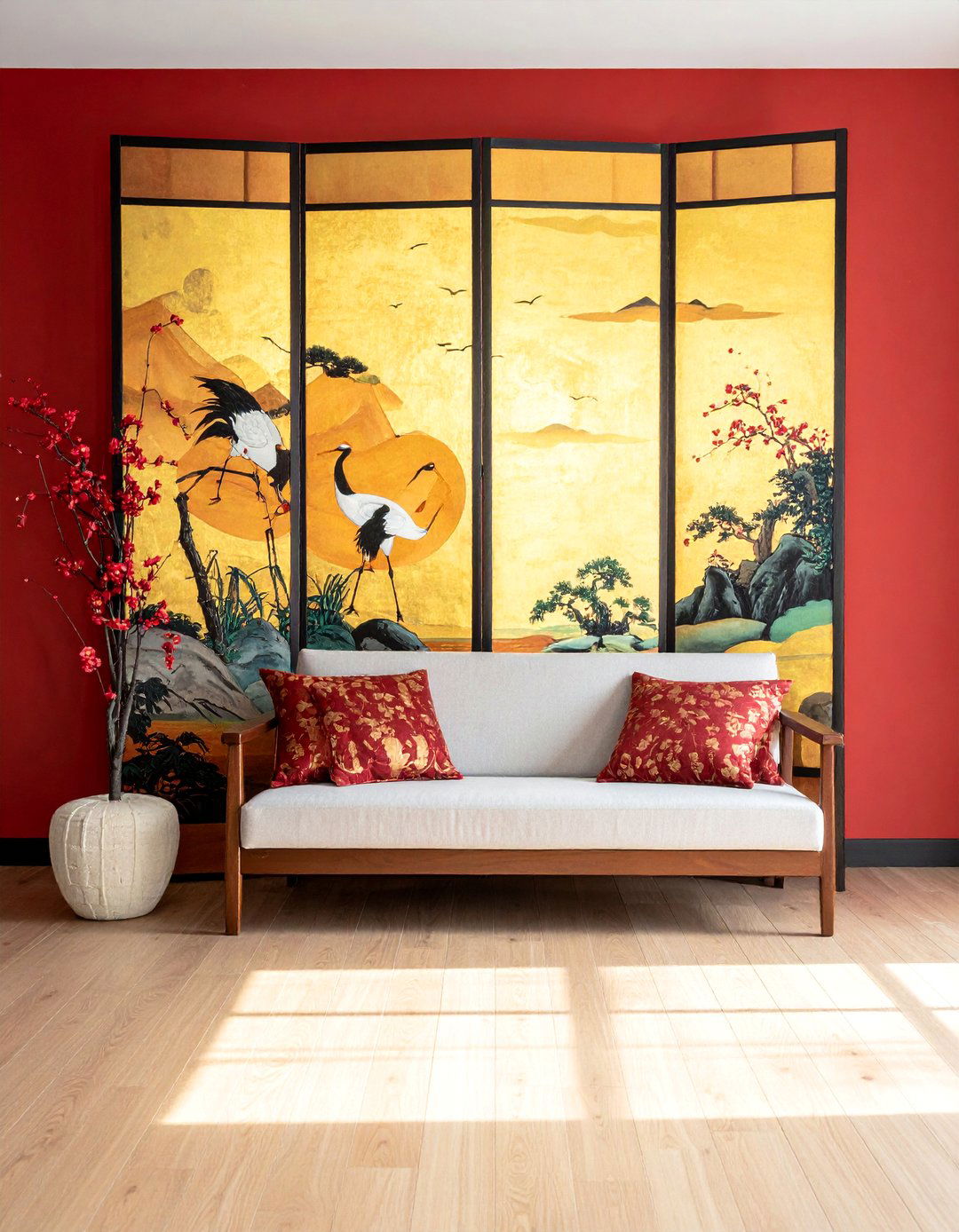
Byobu are multi-panel folding screens that are both functional and highly decorative. In a Japanese living room, they can be used to divide a space, create a private corner, or simply serve as a stunning artistic backdrop. Often adorned with intricate paintings of landscapes, flora, or fauna on a gold-leaf or paper background, a Byobu can be the room's main statement piece. Its presence adds a sense of history, luxury, and artistic flair. The screen's ability to be easily moved and reconfigured also speaks to the Japanese value of flexible and adaptable living spaces, allowing you to change the room's dynamic as needed.
27. A Japanese Living Room with Zabuton Floor Cushions
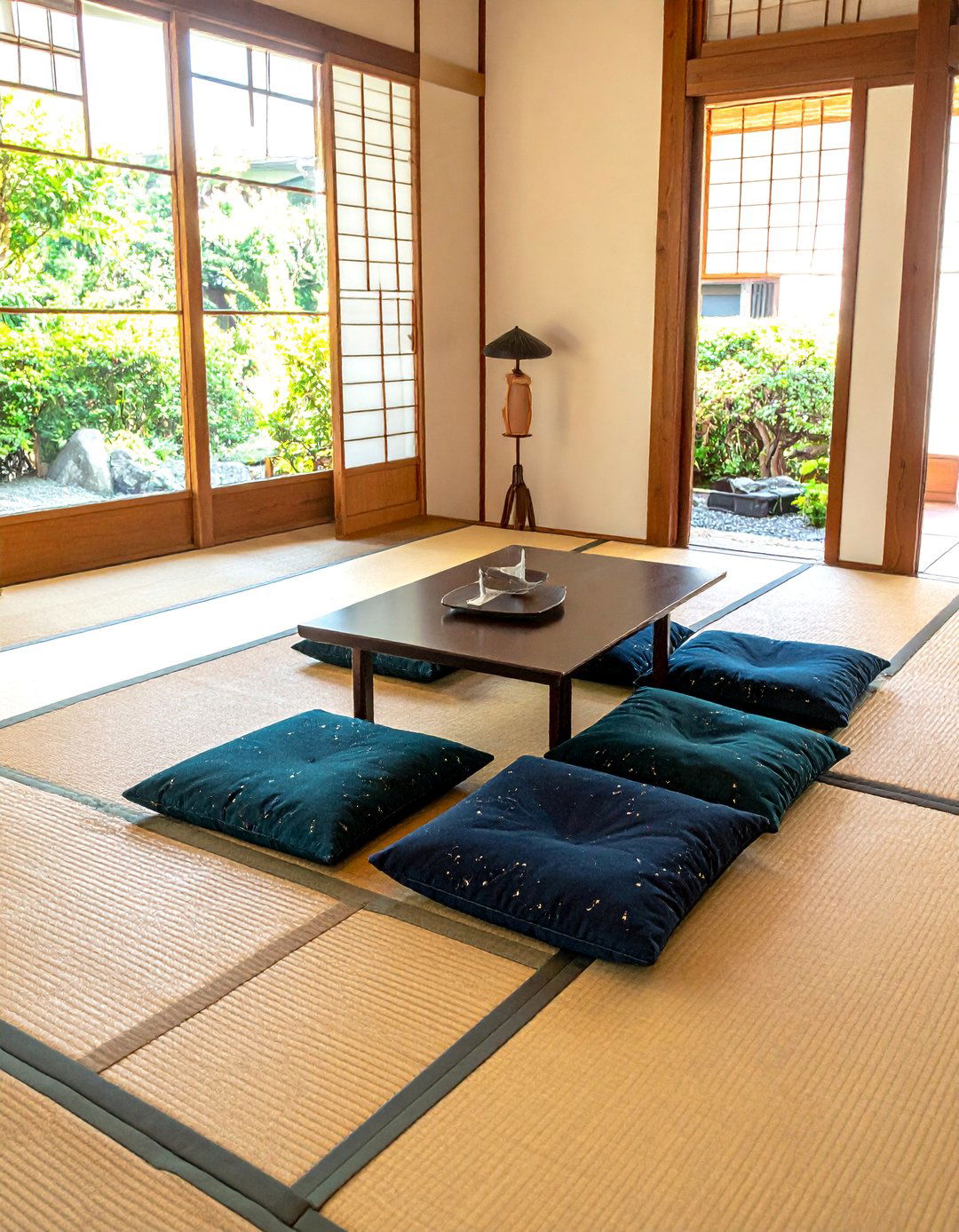
Zabuton are traditional rectangular cushions used for sitting on the floor in a Japanese living room. Placed directly on tatami mats or a soft rug, they provide comfort while maintaining the low-level living style. Typically filled with cotton and covered in silk or cotton fabric, they come in various colors and patterns, offering a subtle way to introduce texture and accent colors into the room. Arranging a few zabuton around a low chabudai table creates an intimate and inviting space for conversation or enjoying tea. They are a simple, versatile, and essential element for achieving an authentic and comfortable Japanese interior.
28. A Japanese Living Room with Minimalist Floating Shelves
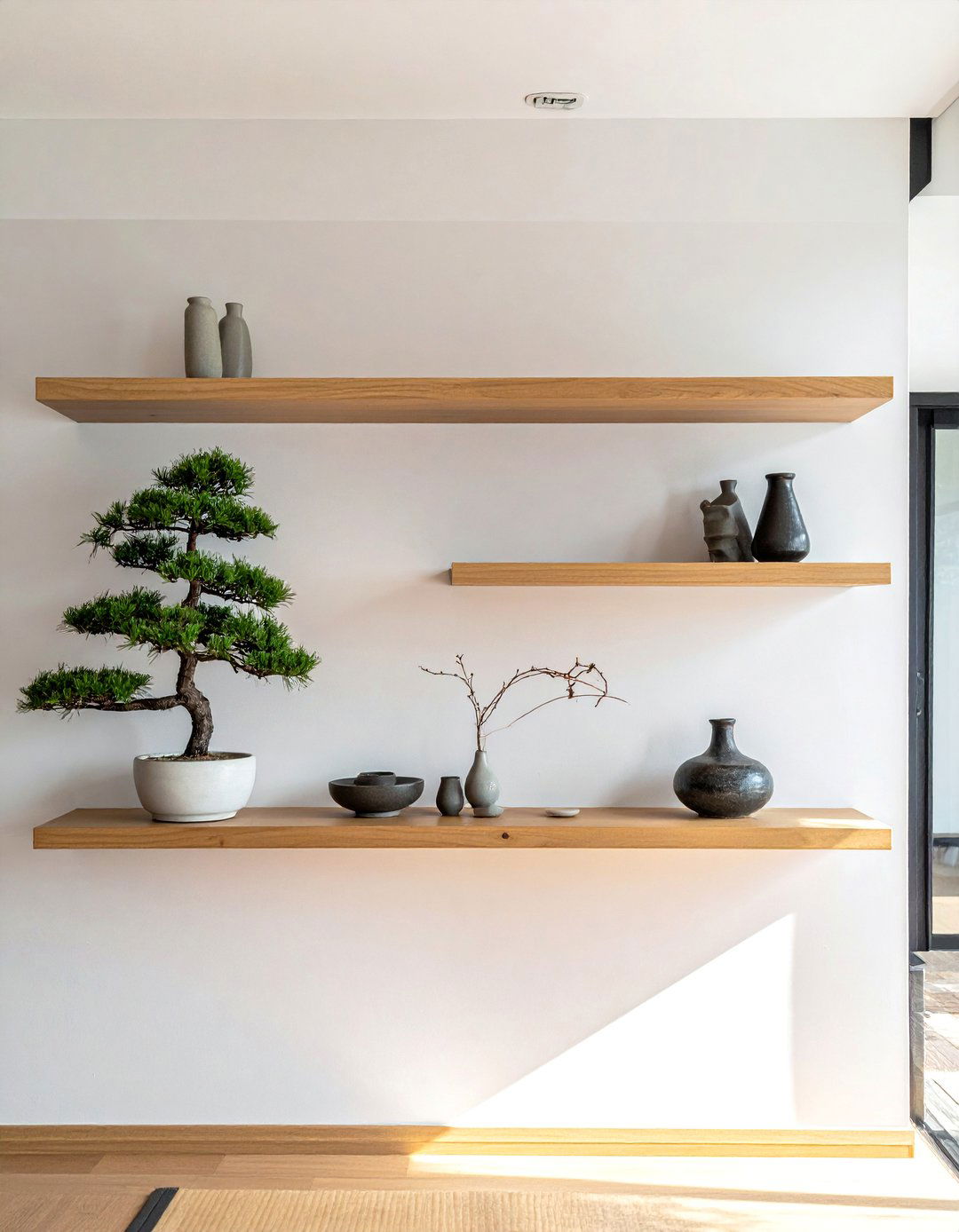
To maintain an uncluttered aesthetic while still allowing for some display, minimalist floating shelves are an excellent choice for a Japanese living room. Made from natural wood and installed with concealed hardware, these shelves appear to float on the wall, reinforcing the room's airy and open feel. They provide the perfect platform for a few carefully curated objects—a small bonsai tree, a single ceramic vase, or a framed piece of calligraphy. This approach to display aligns with the "less is more" philosophy, ensuring that your treasured items are given the space and attention they deserve without creating visual noise.
29. A Japanese Living Room with a Meditative Ambiance
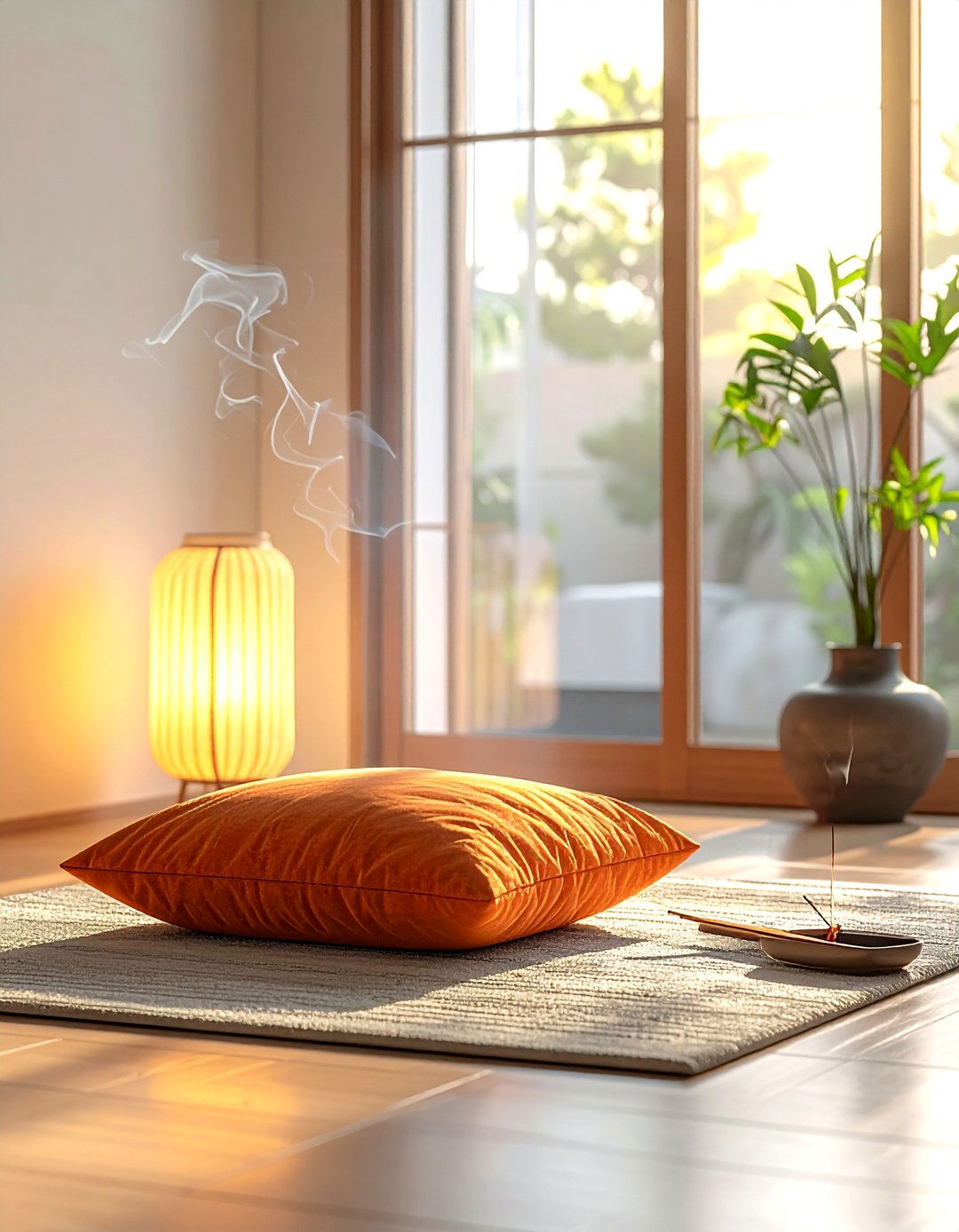
Creating a meditative ambiance is the ultimate goal of a Japanese living room. This is achieved through the thoughtful combination of all design elements: the soft, diffused light from a paper lantern, the calming scent of tatami or hinoki wood, the quiet presence of a single plant, and the orderliness of a clutter-free space. The room should be a sanctuary that encourages you to slow down, breathe deeply, and be present. Gentle, nature-inspired sounds from a small water feature can further enhance this atmosphere, turning your living room into a true retreat for mental and spiritual rejuvenation.
30. A Japanese Living Room Inspired by a Ryokan Inn
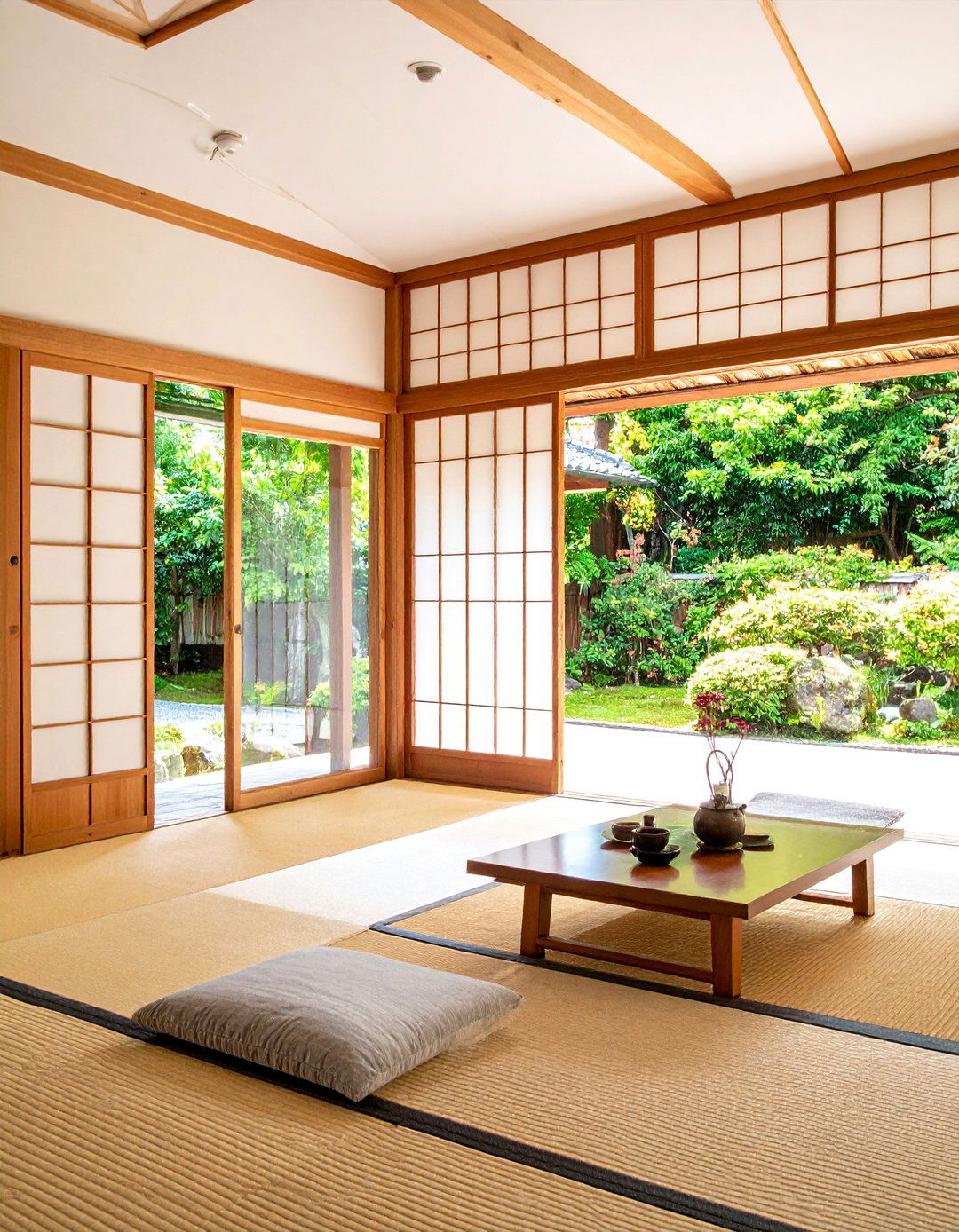
Drawing inspiration from a traditional Japanese inn, or "ryokan," can help you create an authentic and immersive living room experience. This style emphasizes hospitality, comfort, and a deep connection to nature and tradition. Key elements include tatami mat flooring, sliding fusuma doors, a low table with zabuton cushions, and a Tokonoma alcove. The material palette would be rich in natural wood, bamboo, and paper. The overall feeling should be one of understated elegance and profound tranquility, creating a space where you and your guests can feel completely at ease, as if you have stepped into a serene retreat.
Conclusion:
Creating a Japanese living room is an exercise in mindful design, focusing on simplicity, nature, and tranquility. By integrating key elements like Shoji screens, tatami mats, low-profile furniture, and a neutral color palette, you can craft a space that is more than just visually appealing—it becomes a sanctuary for peace and reflection. The core principles of embracing natural light, minimizing clutter, and valuing empty space work together to cultivate a Zen atmosphere. This approach transforms your living area into a harmonious retreat that calms the mind and nurtures a deeper connection to the environment.

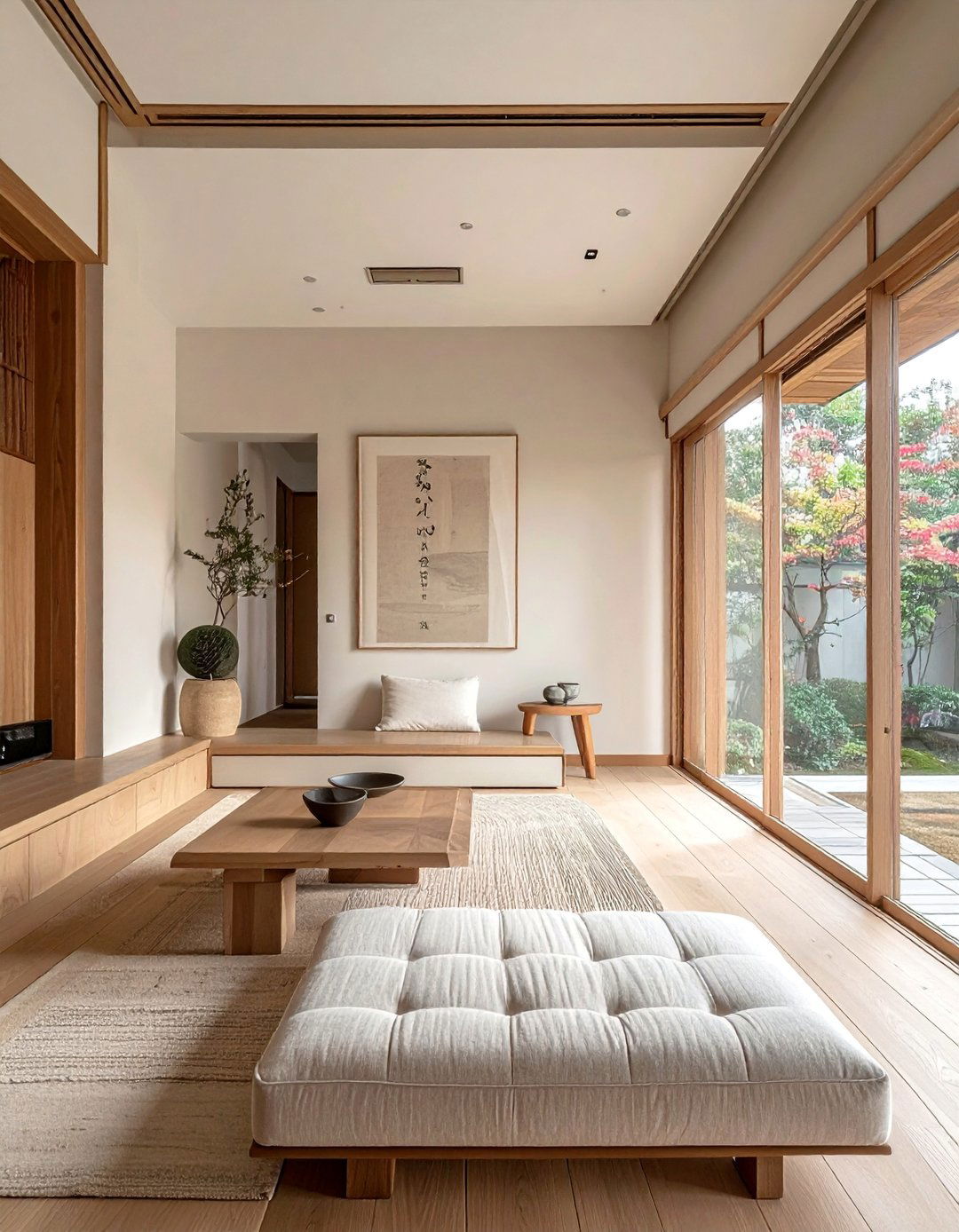
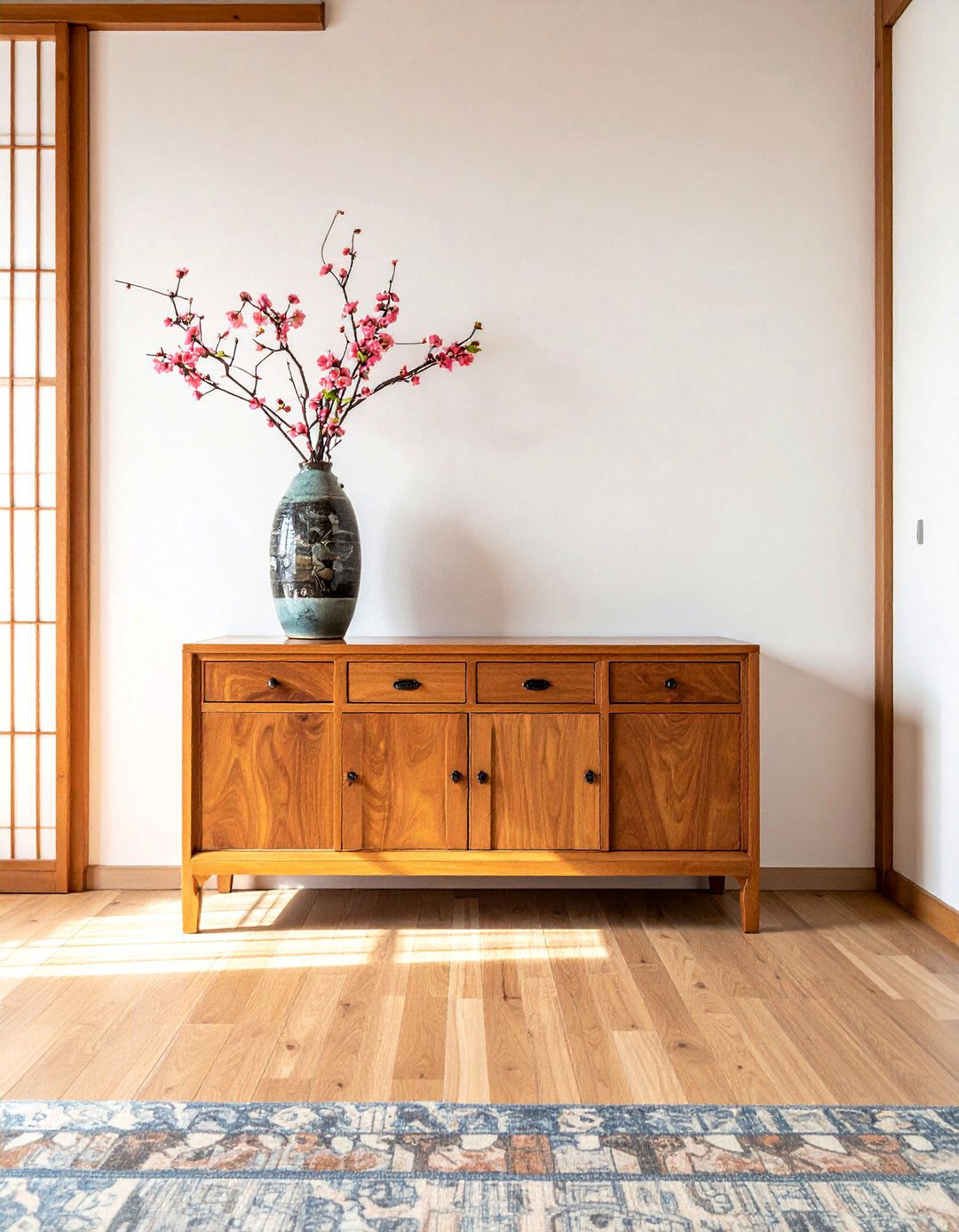
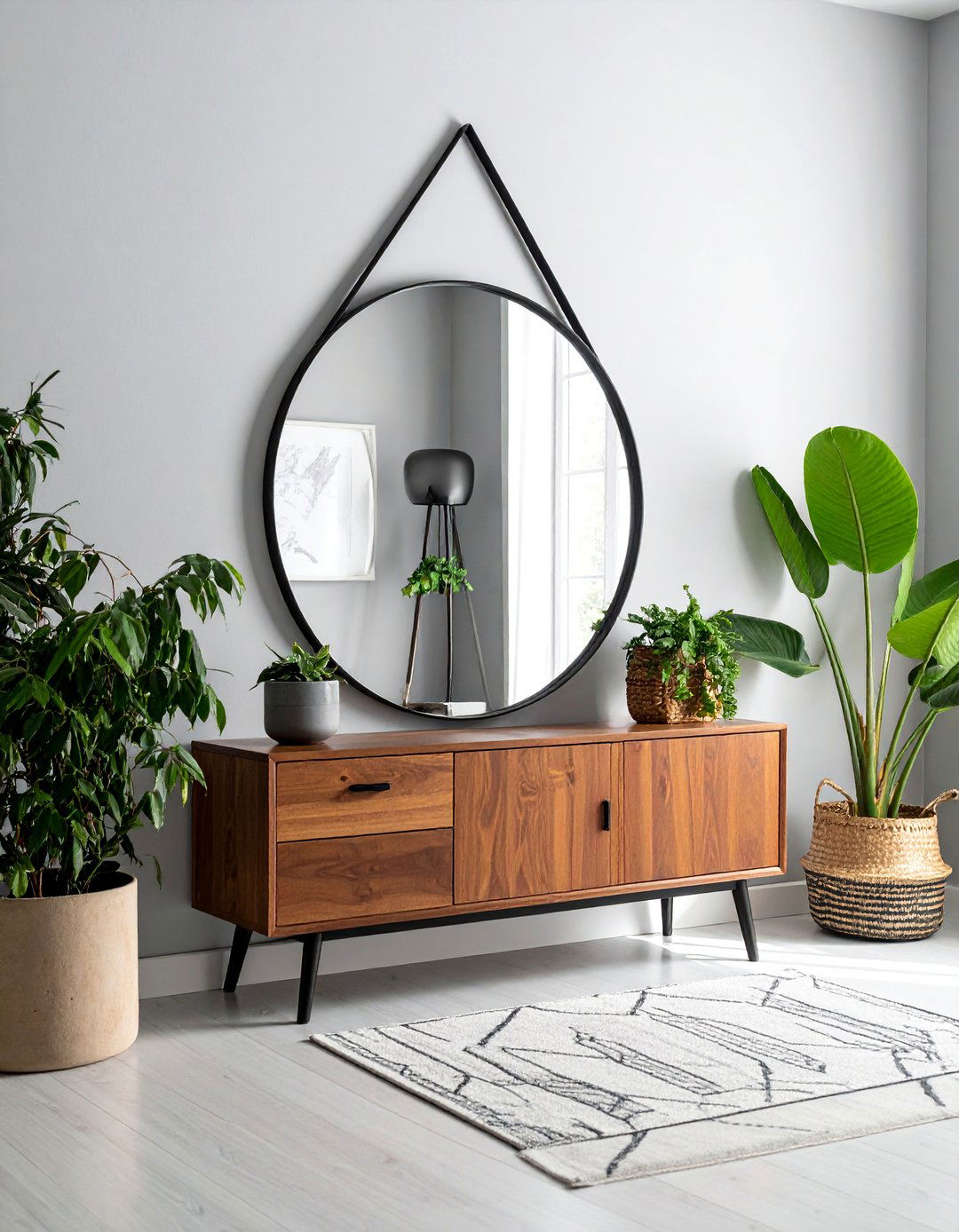
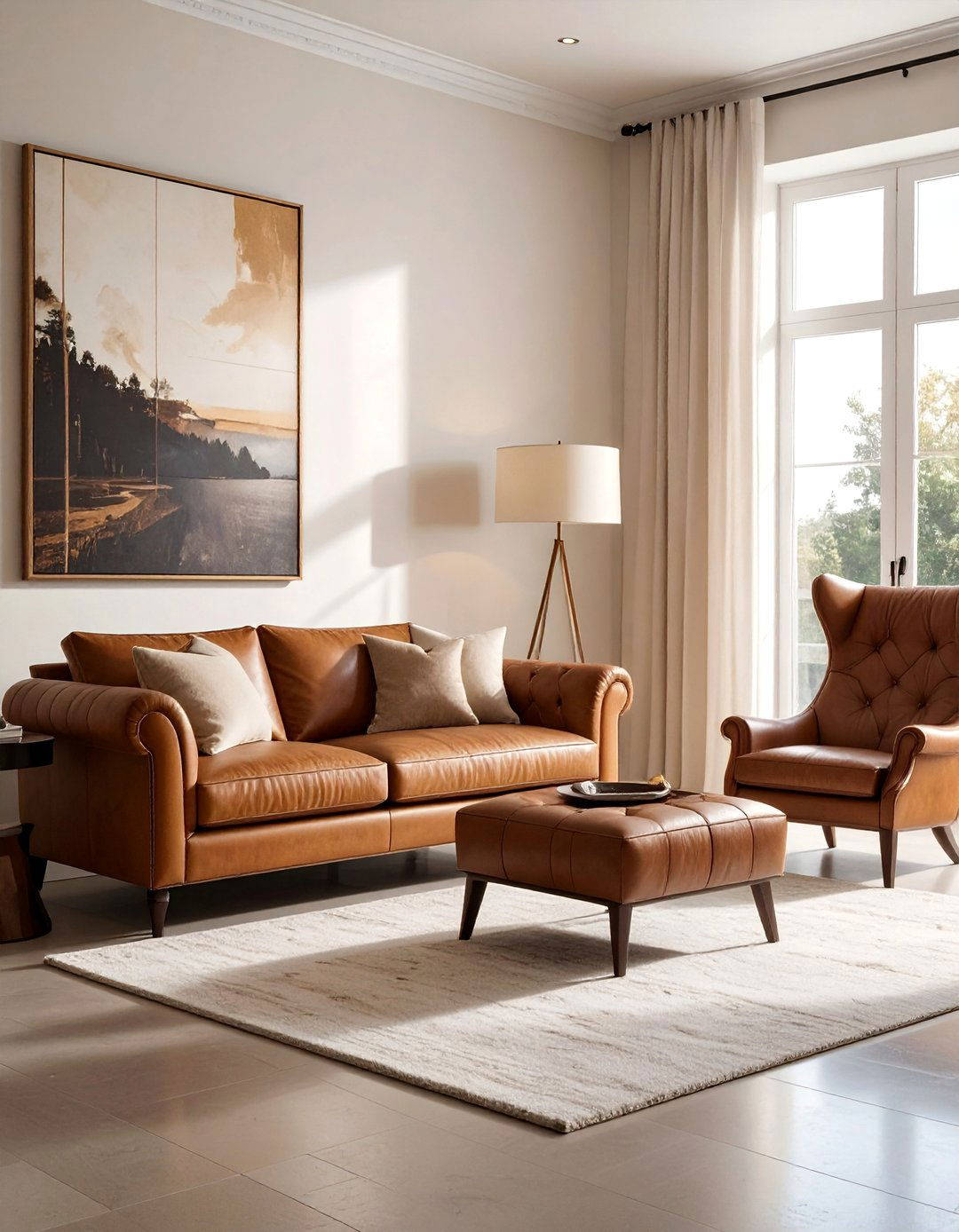

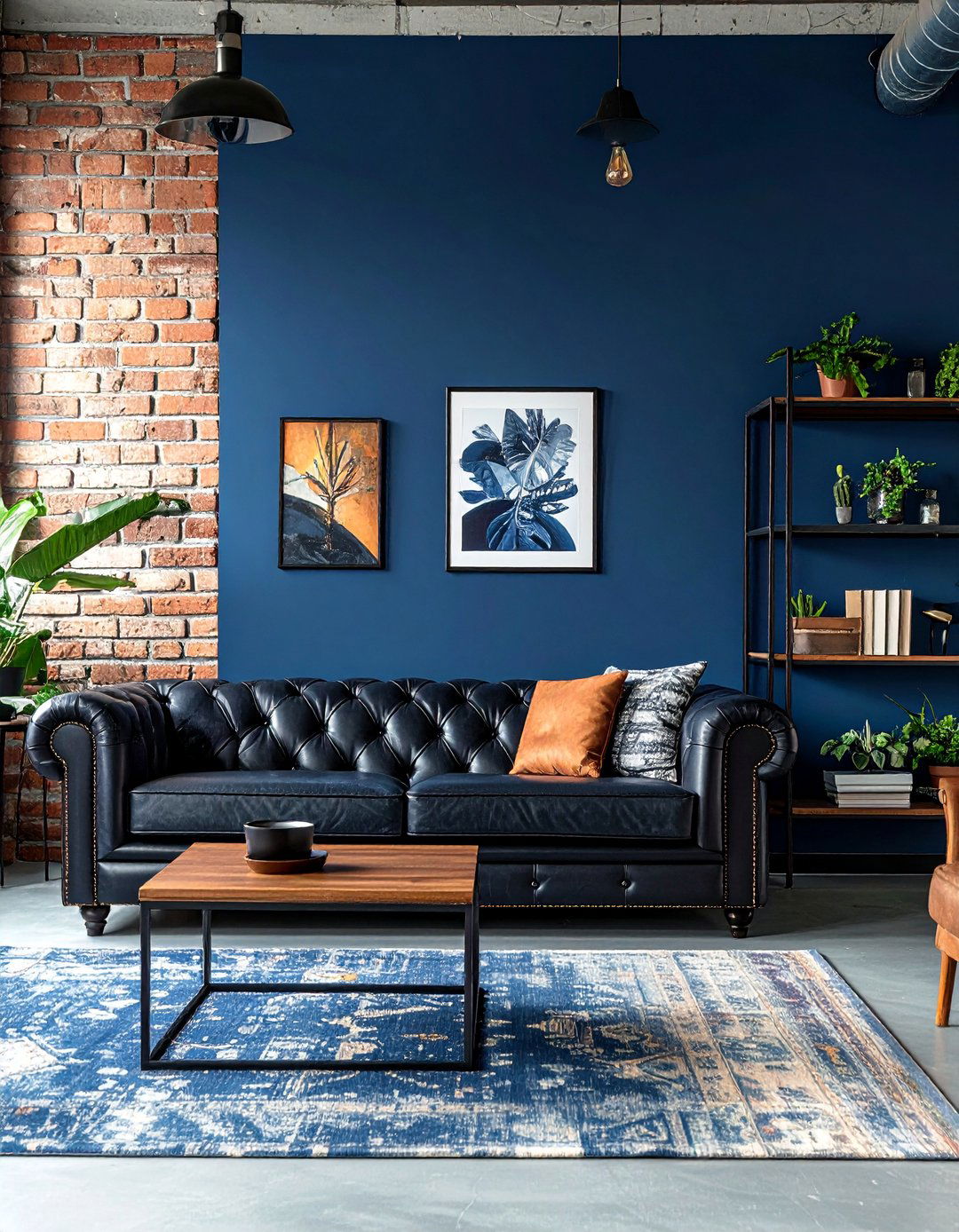
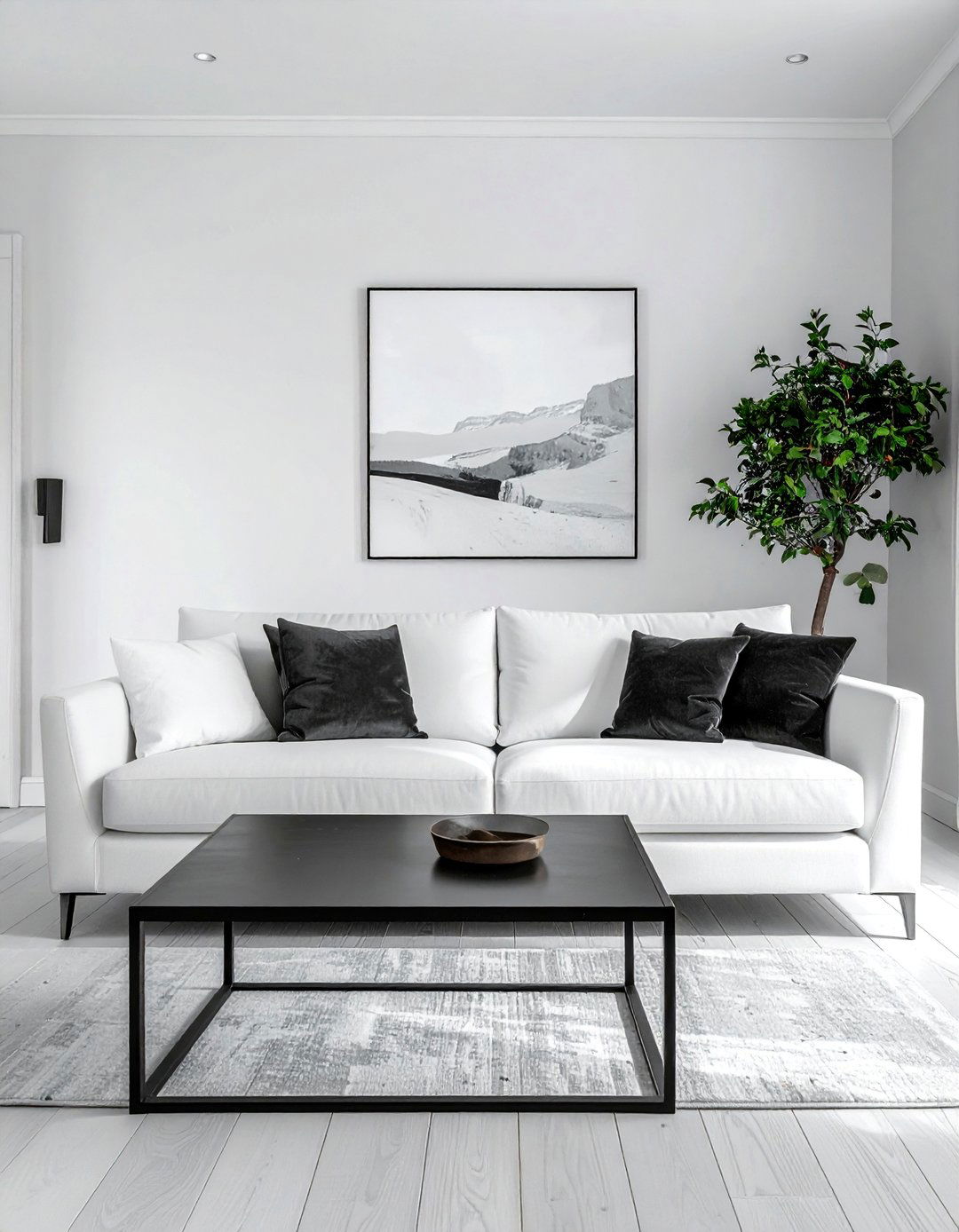
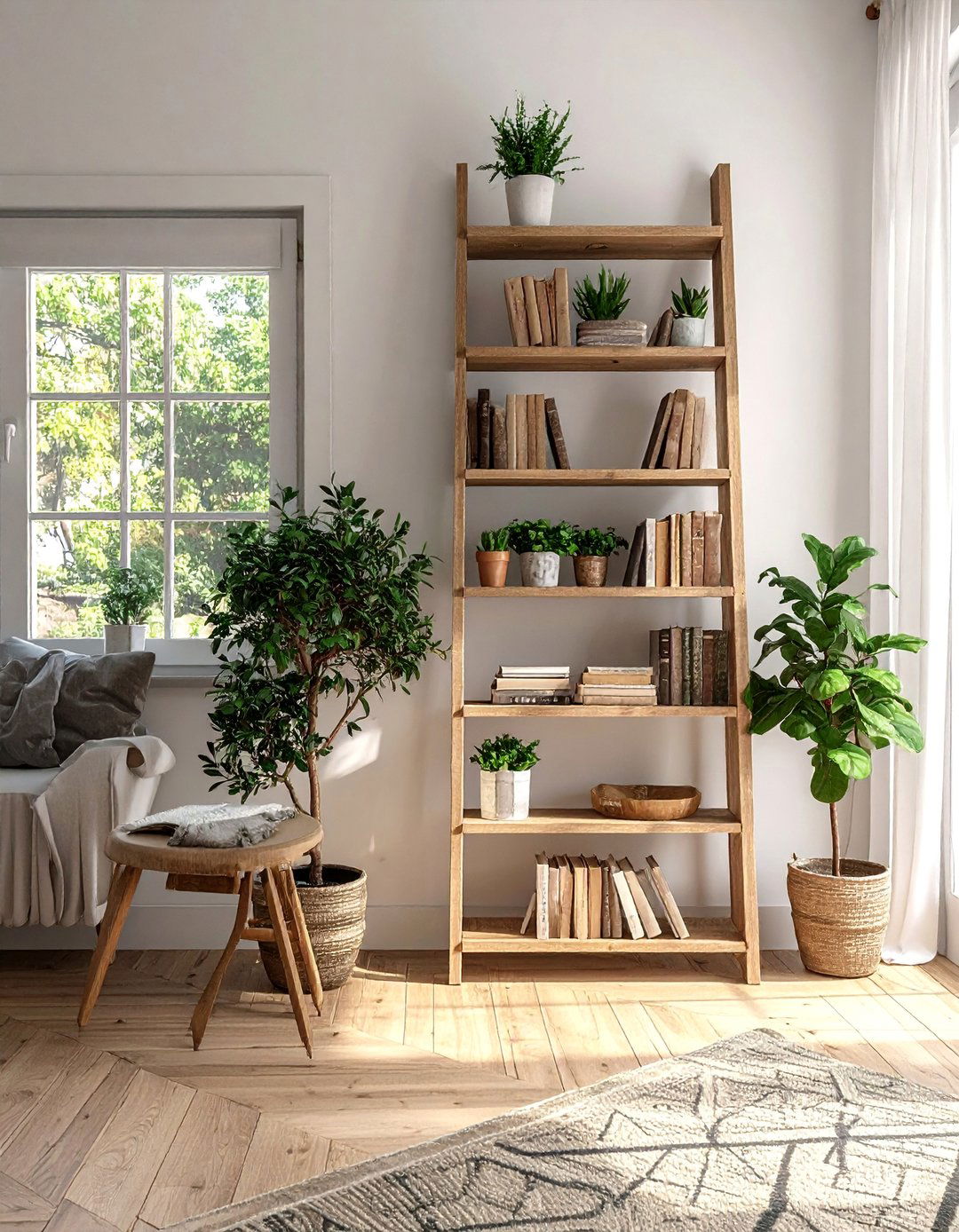
Leave a Reply